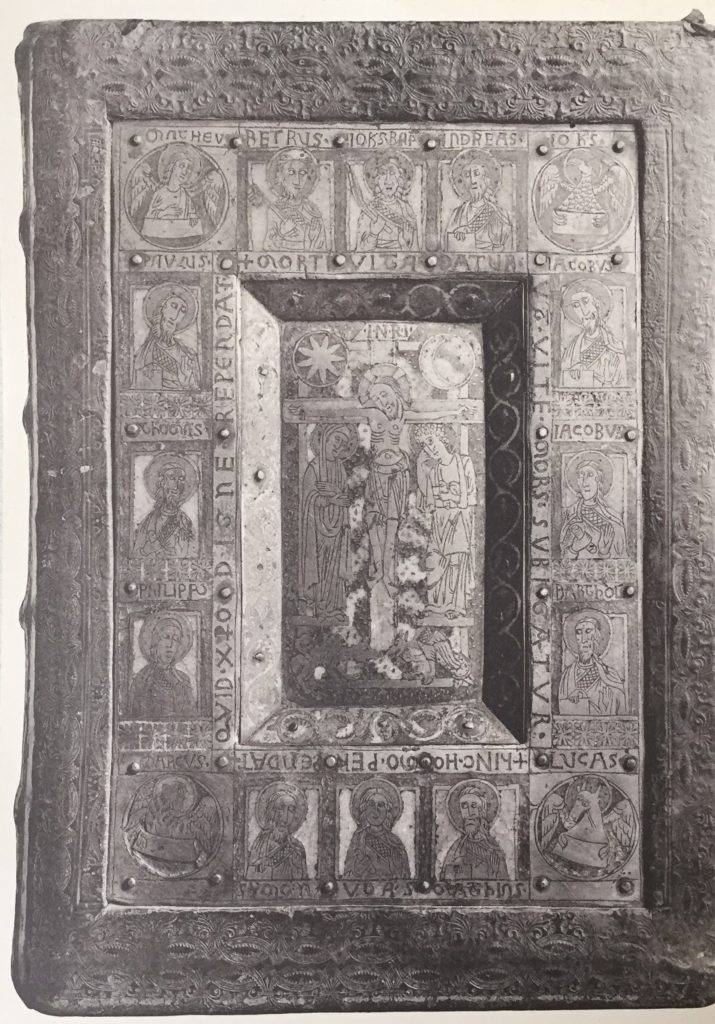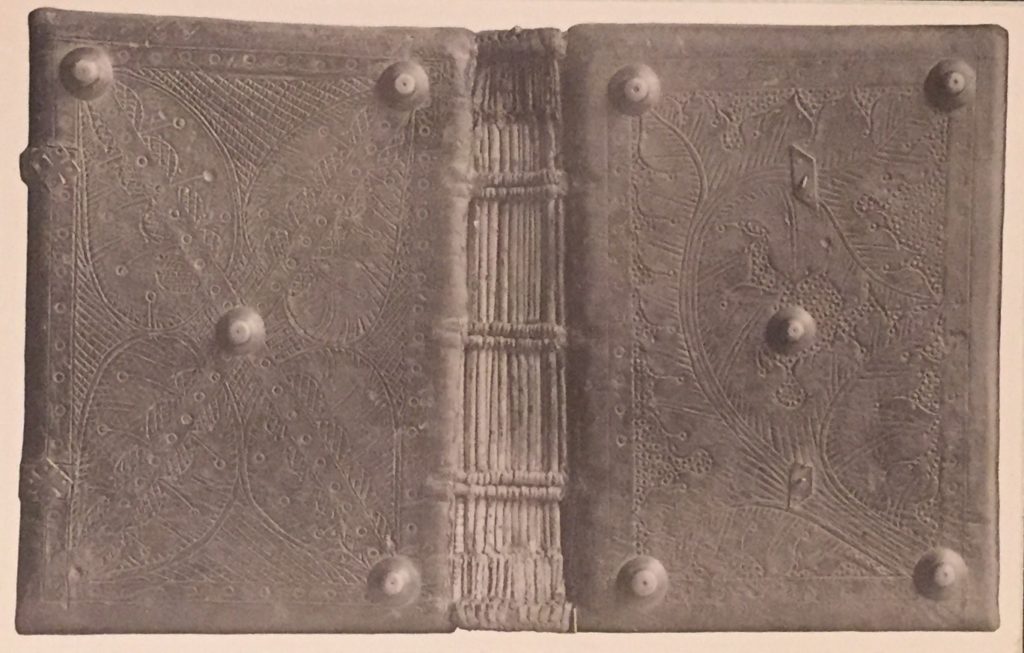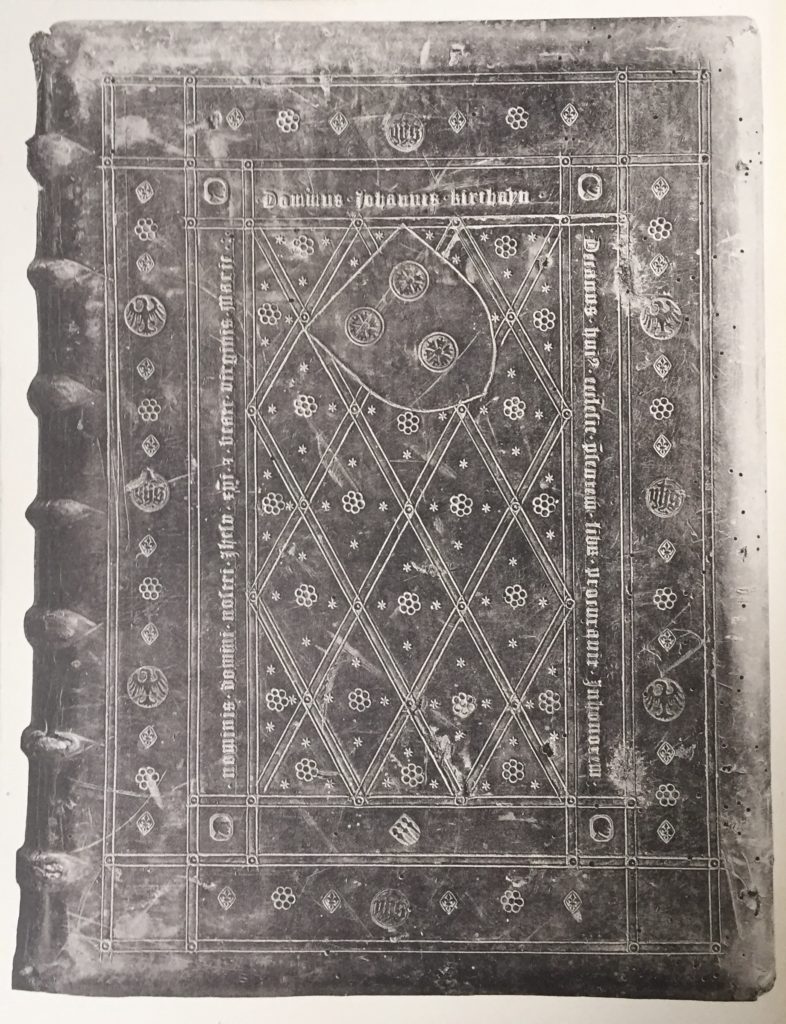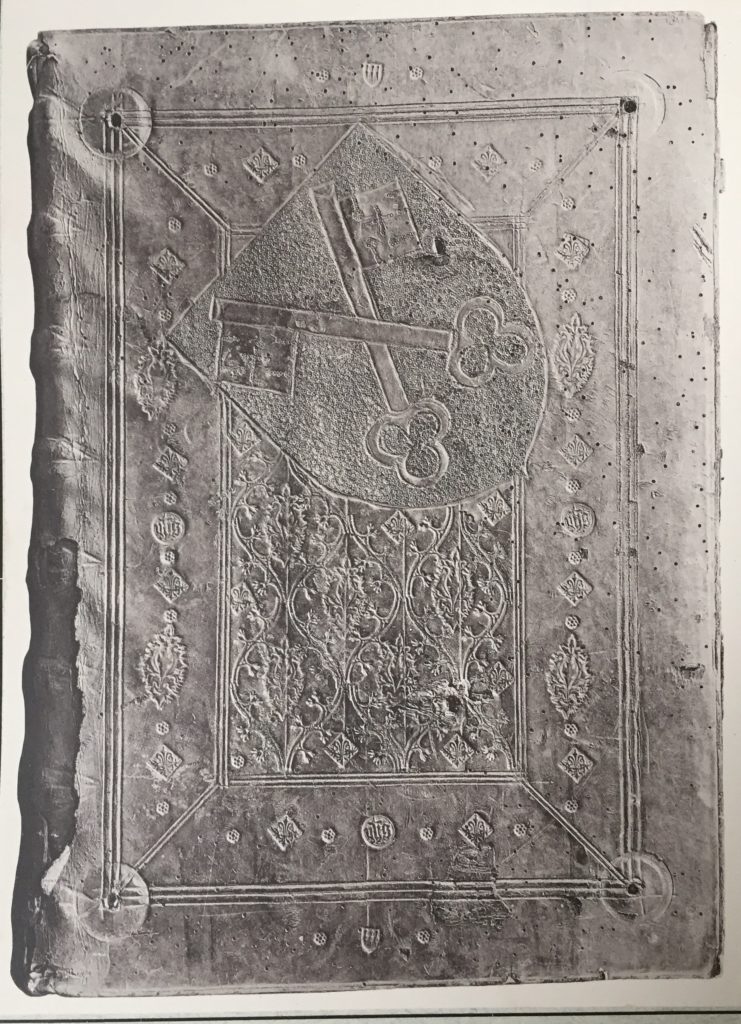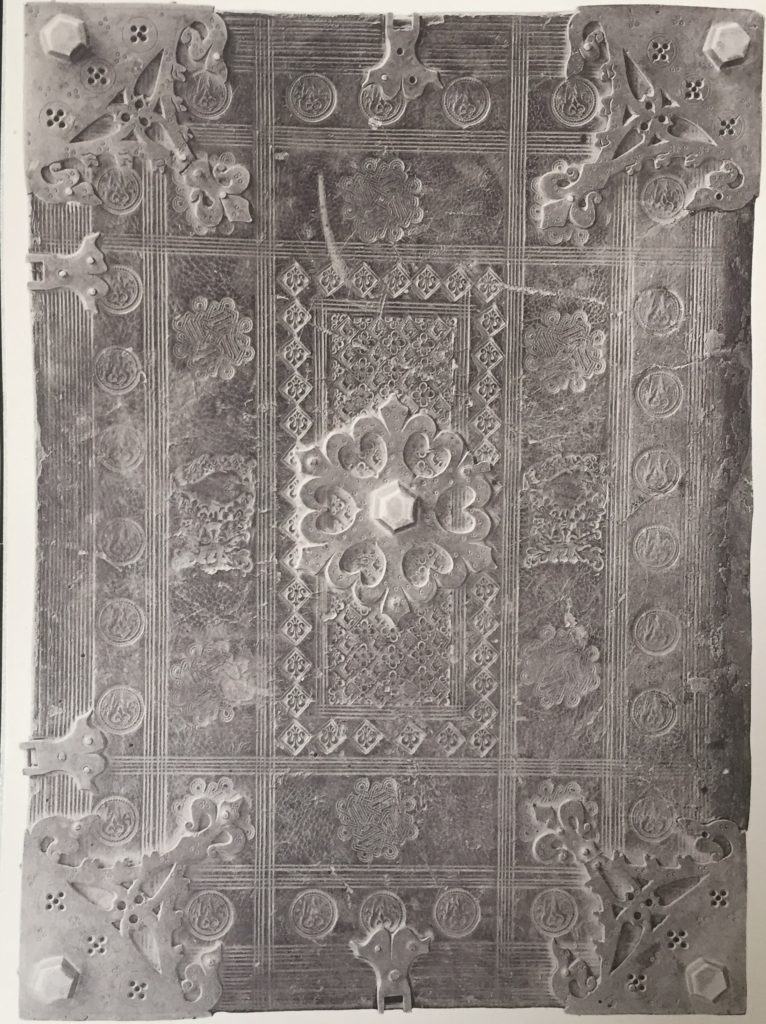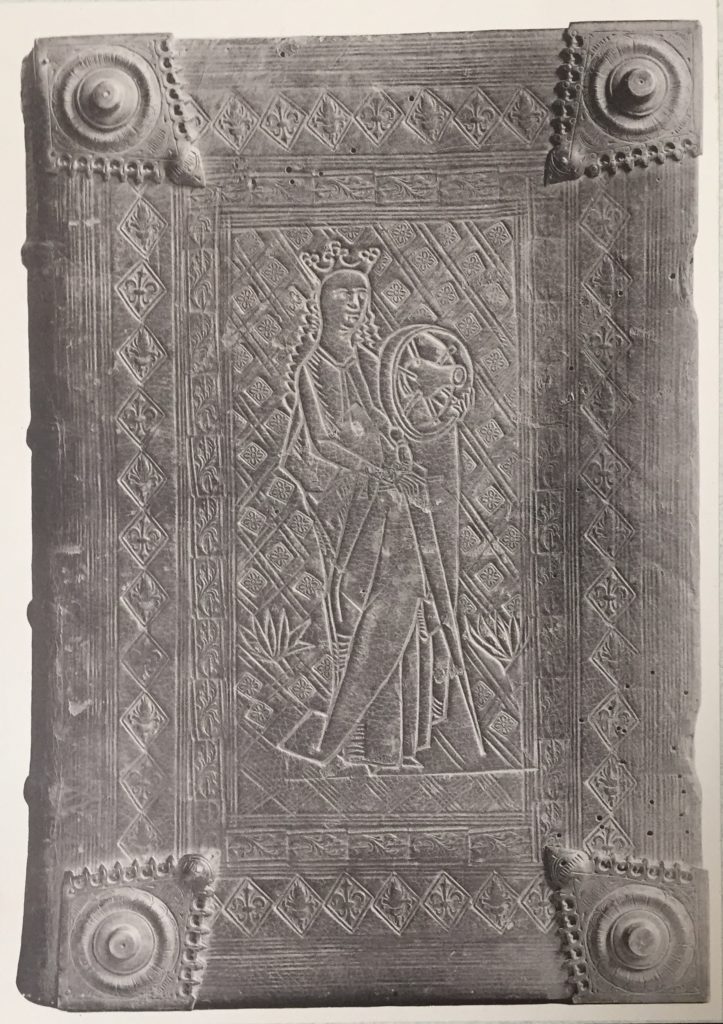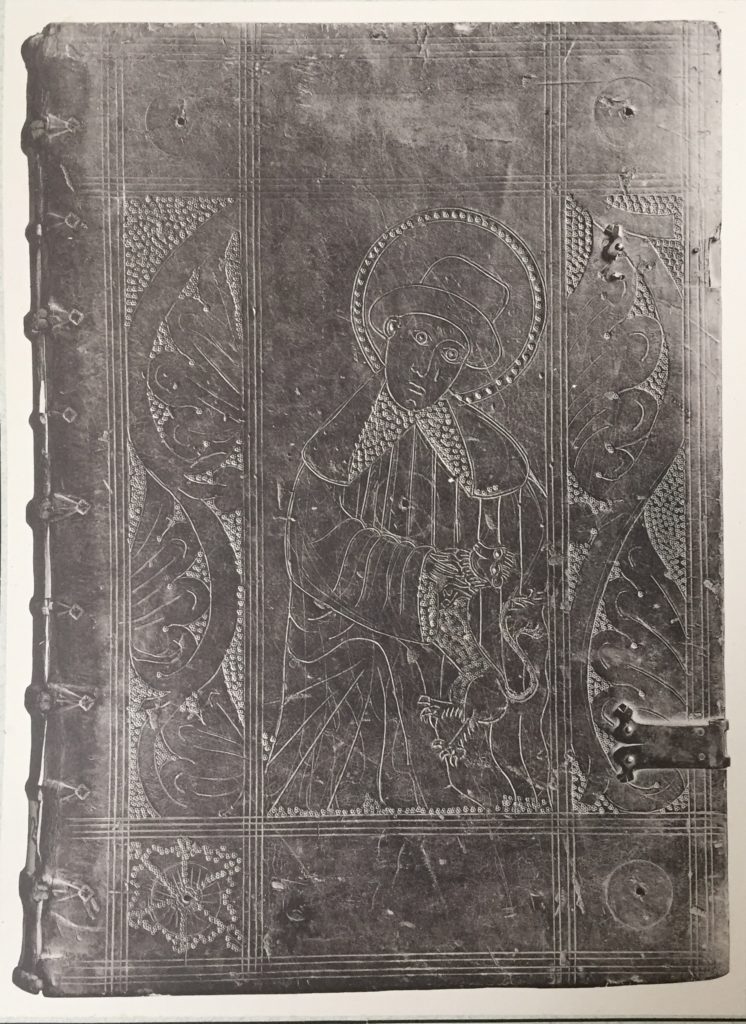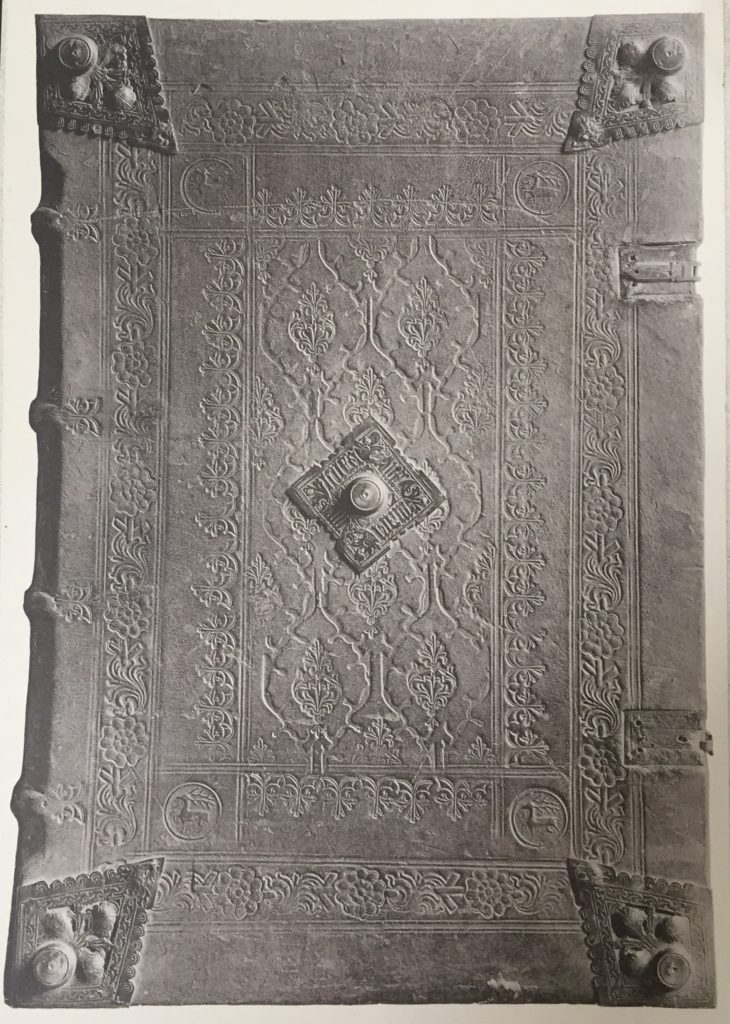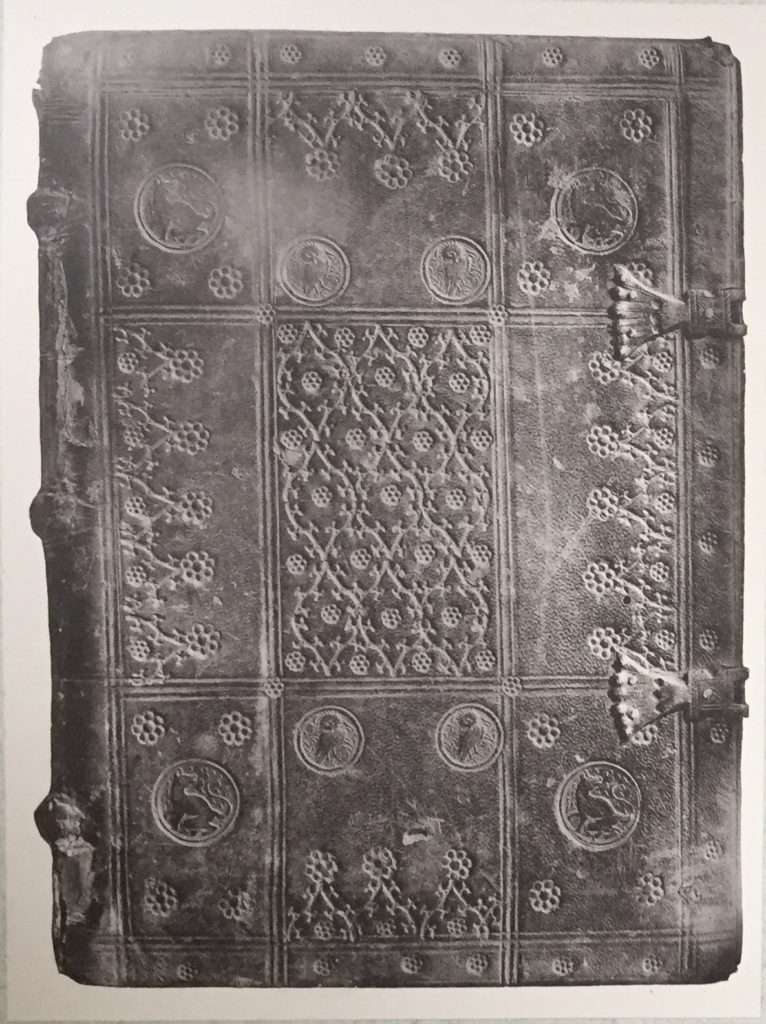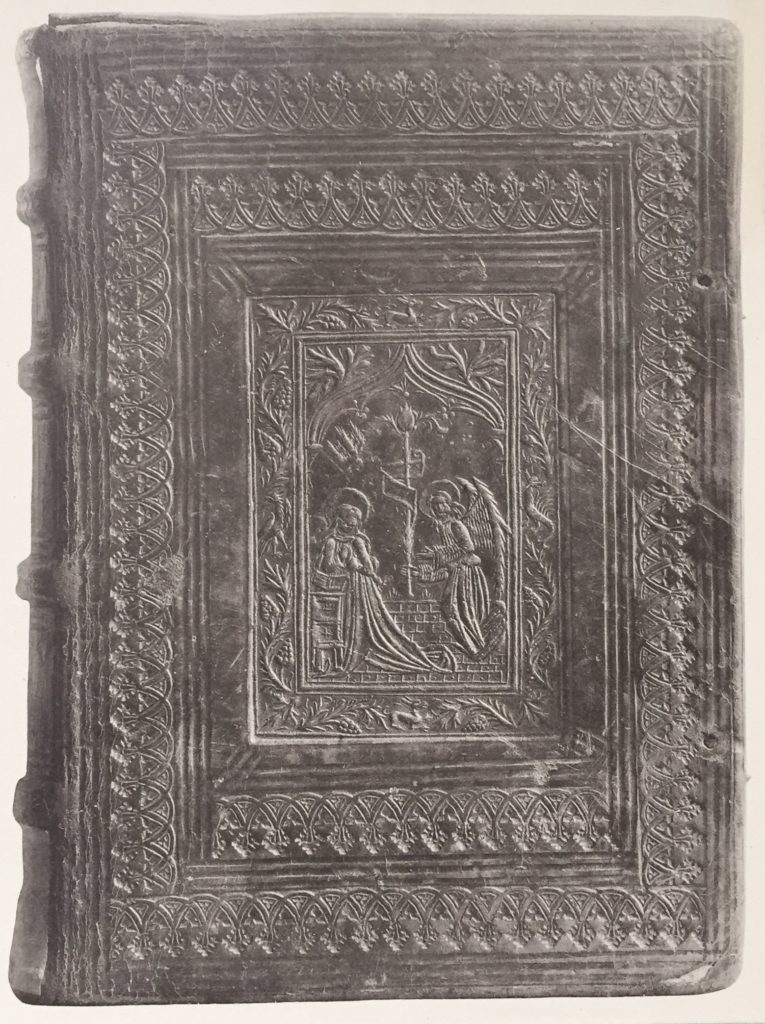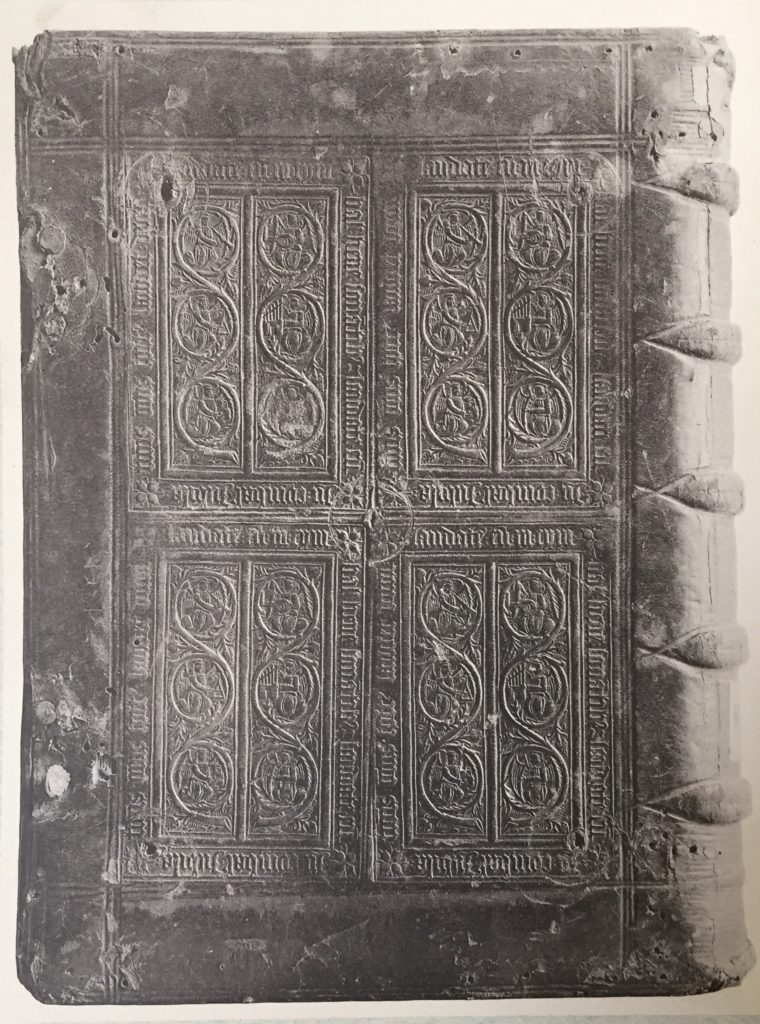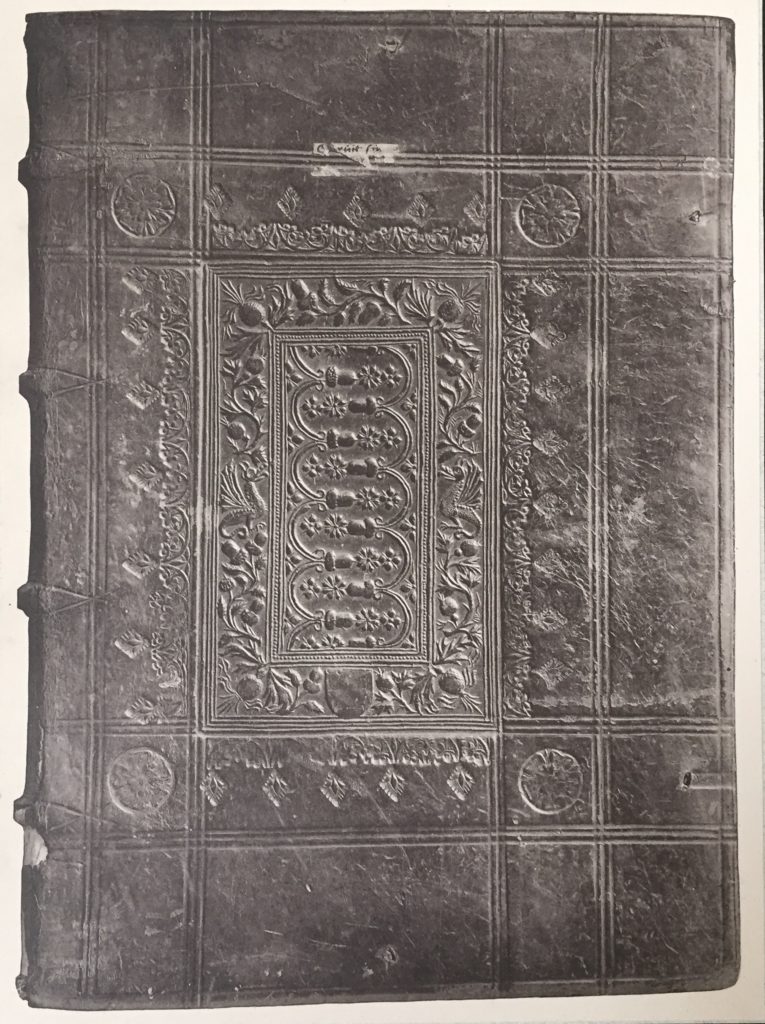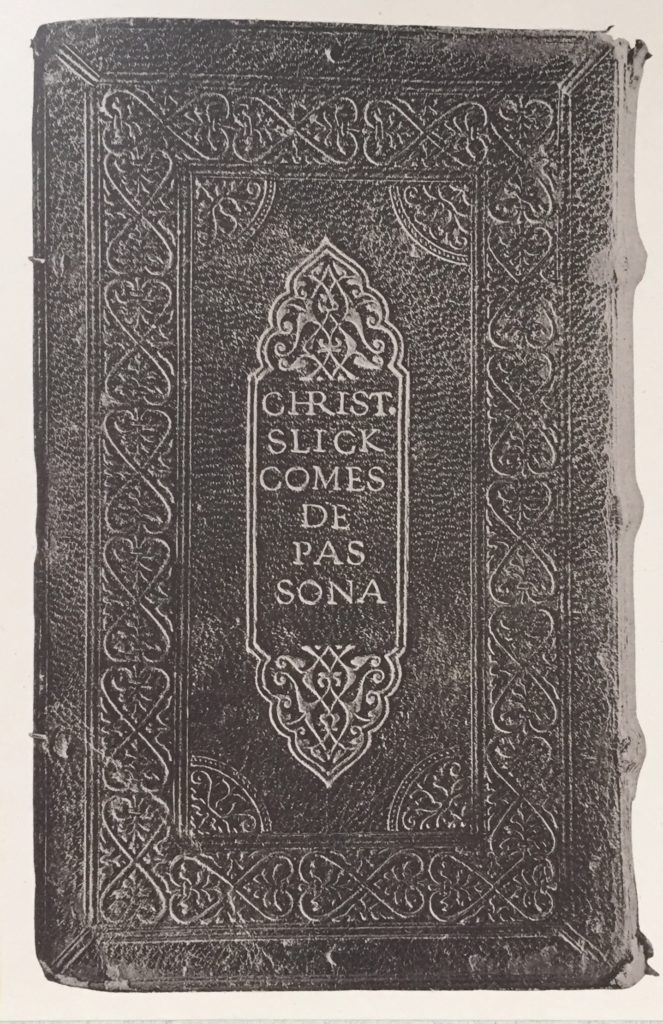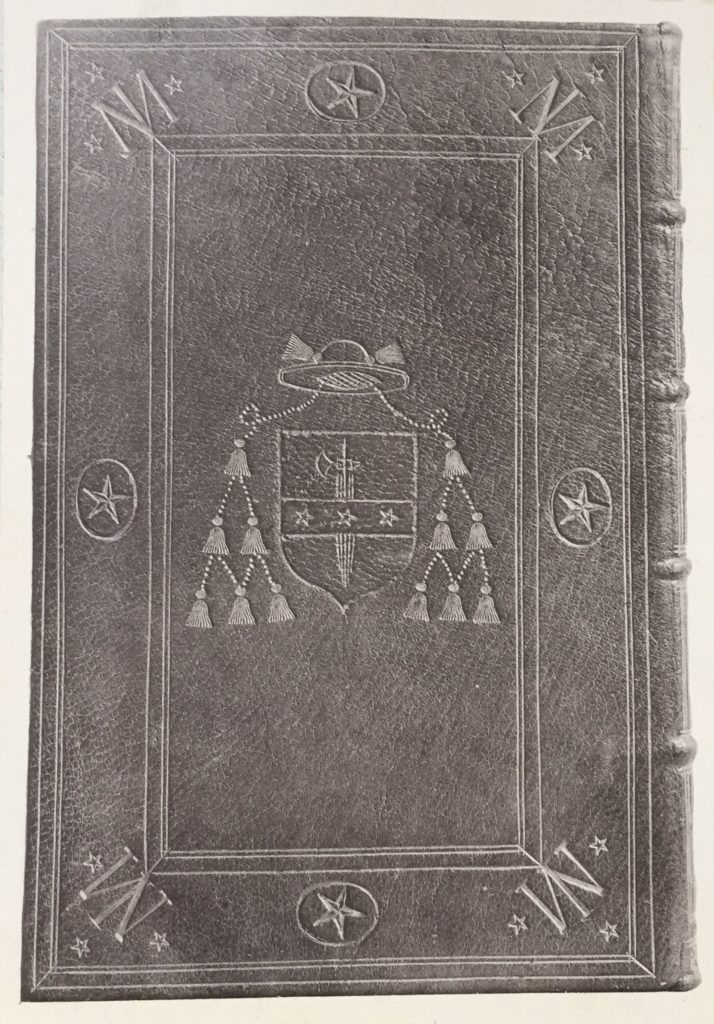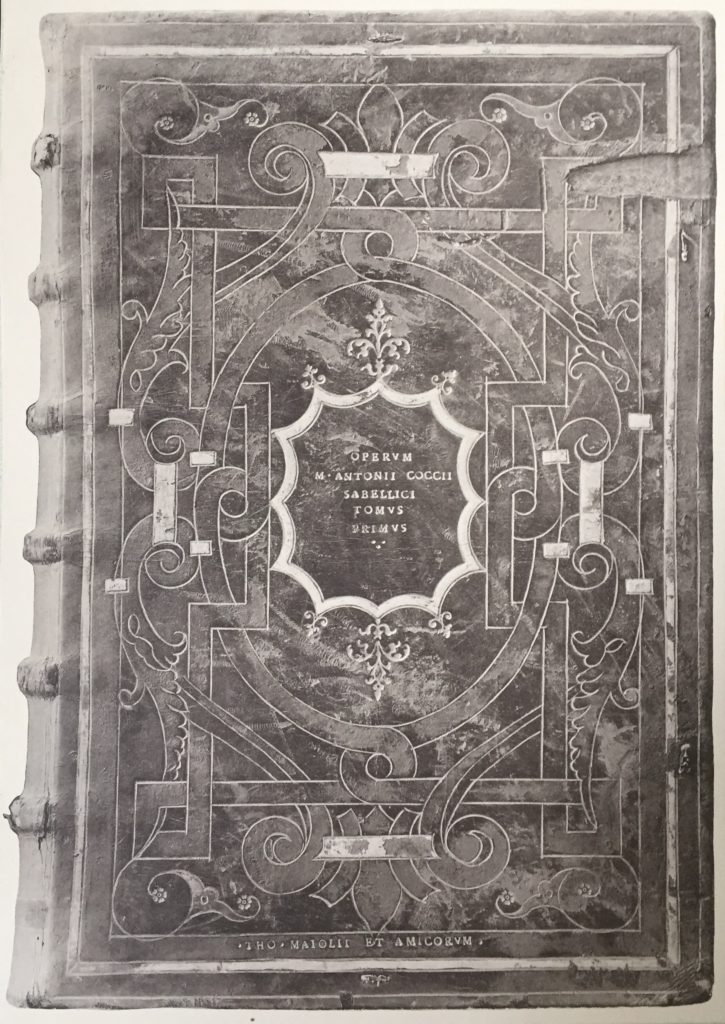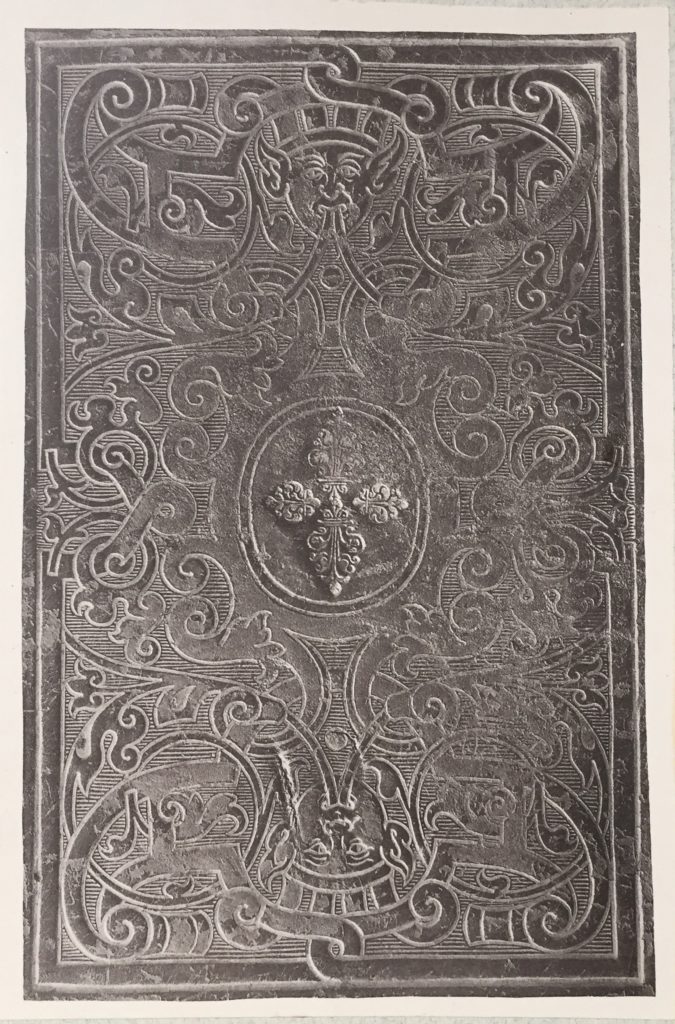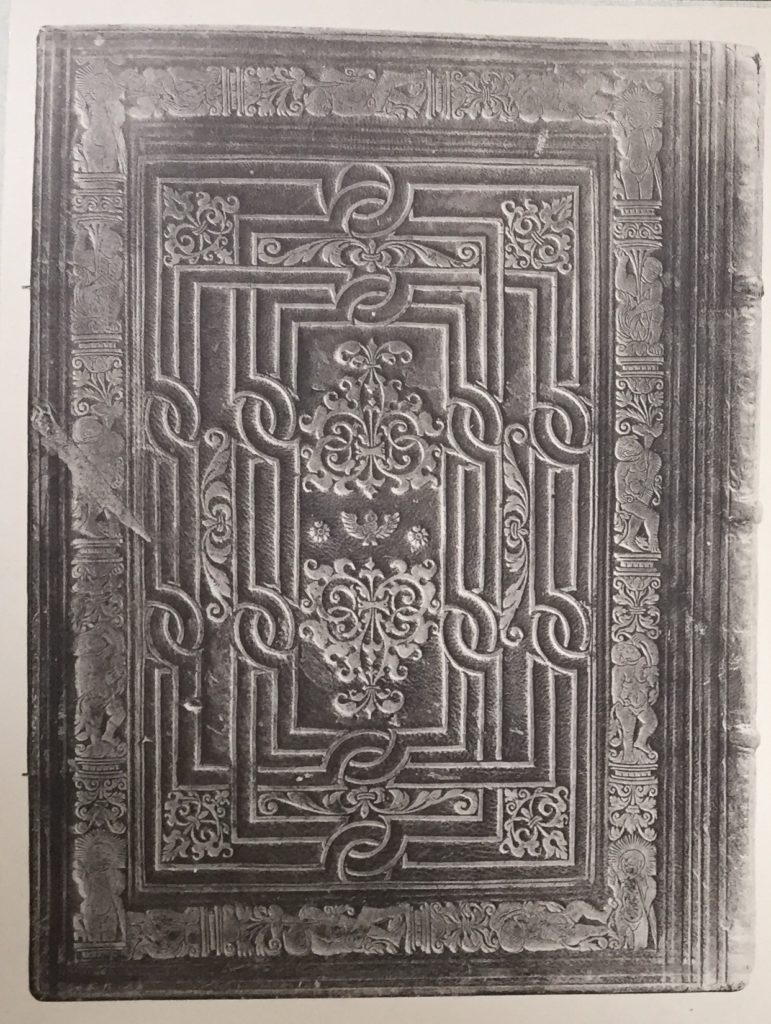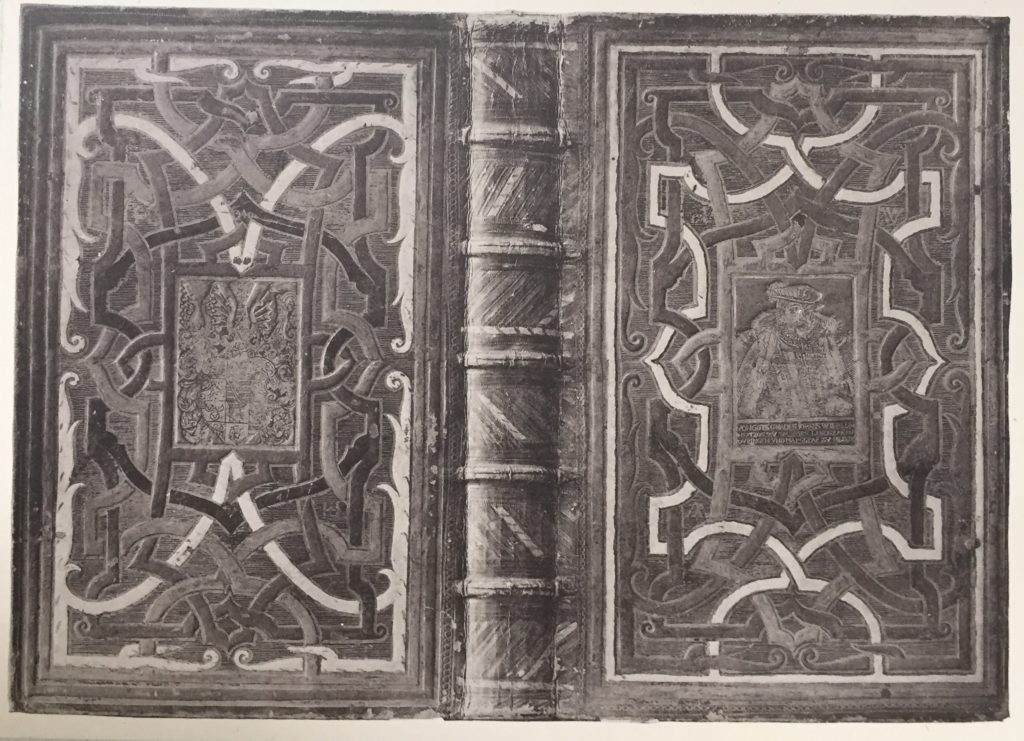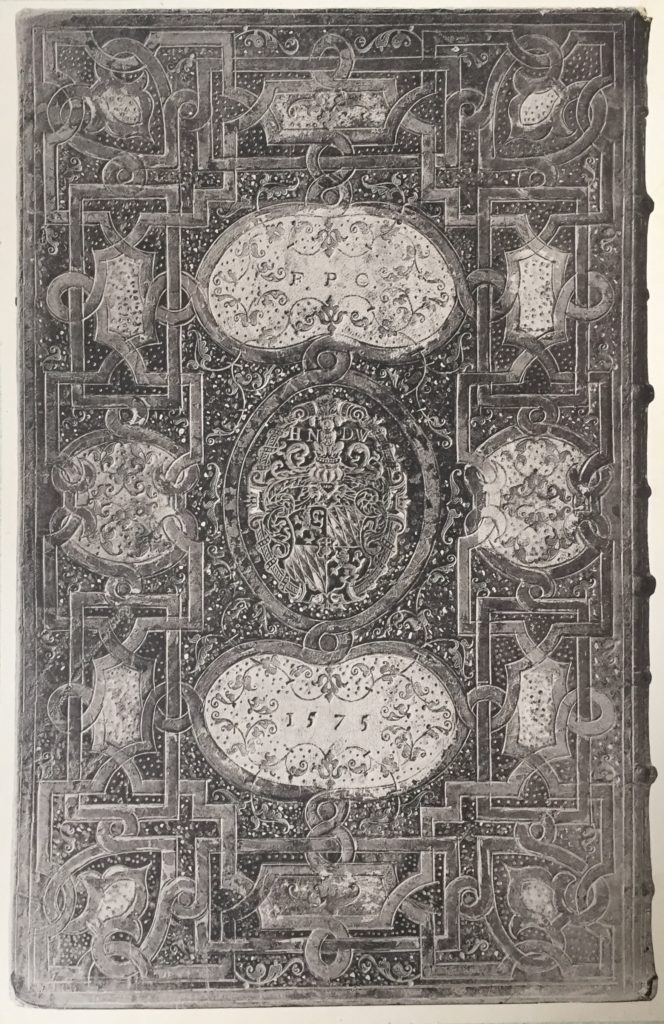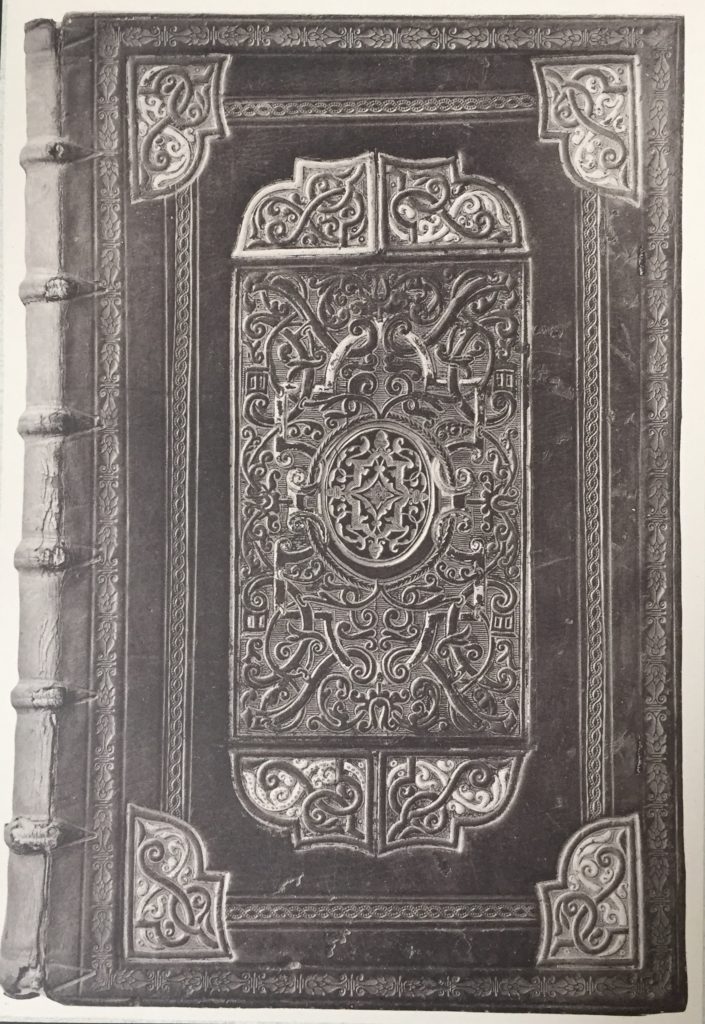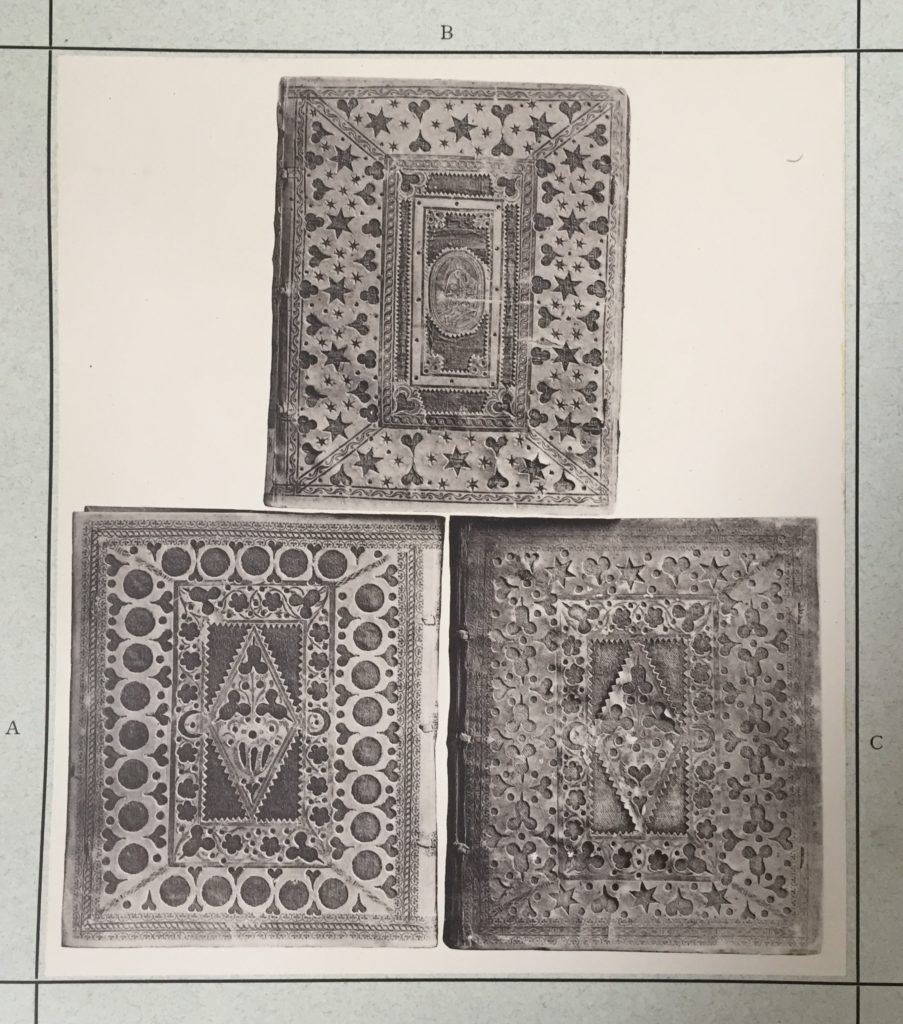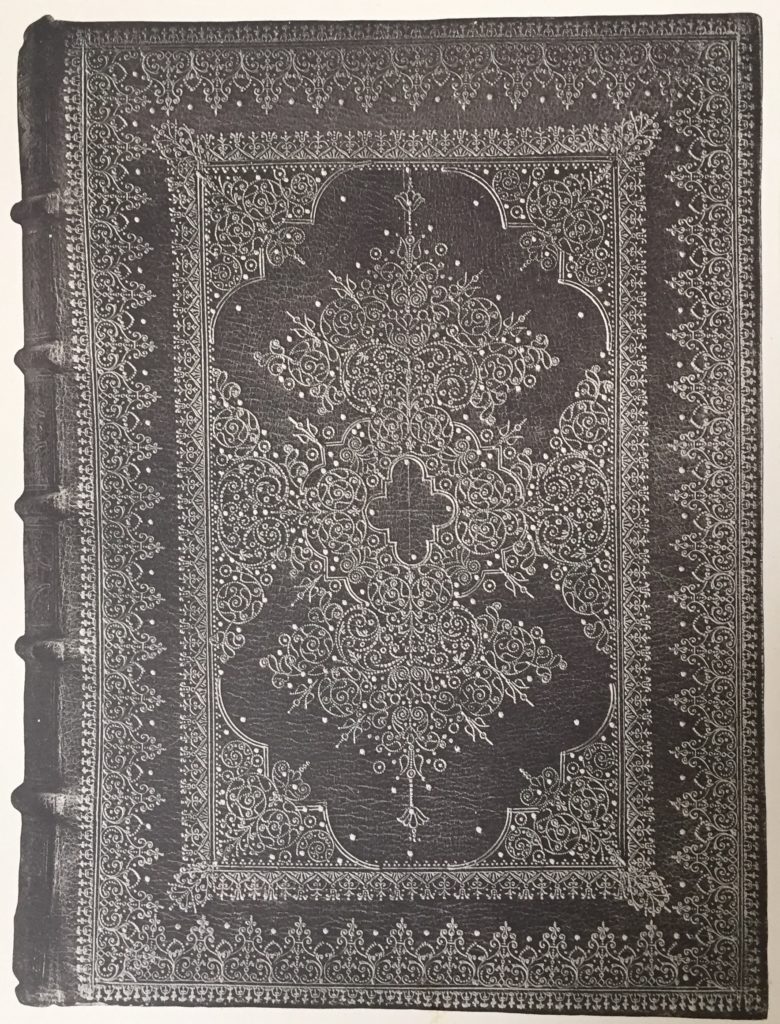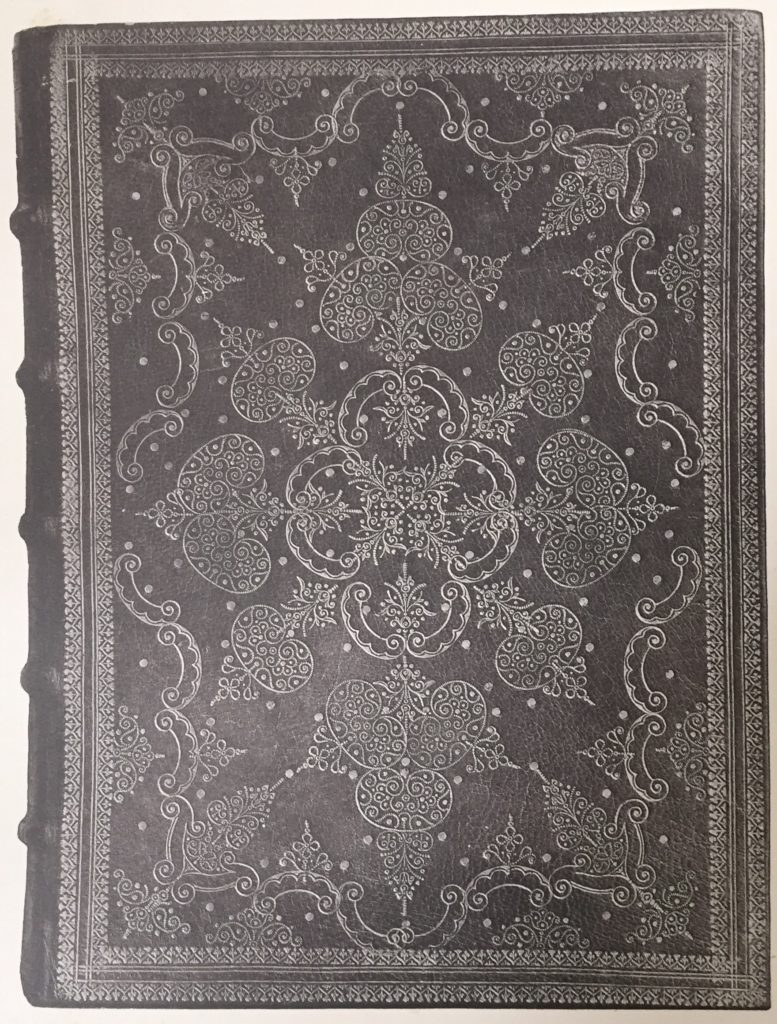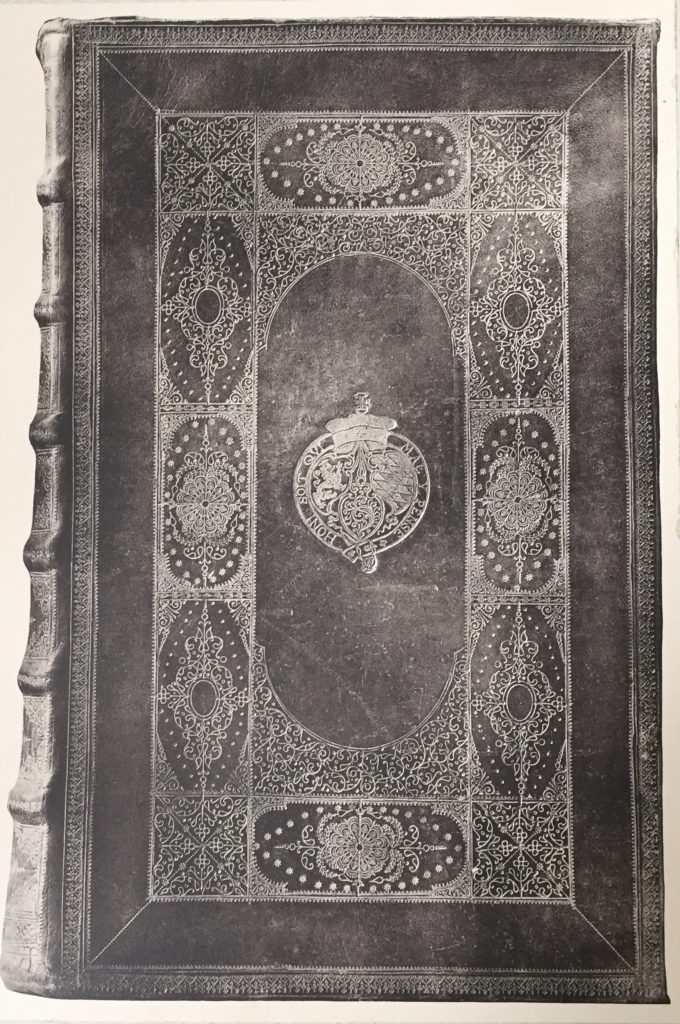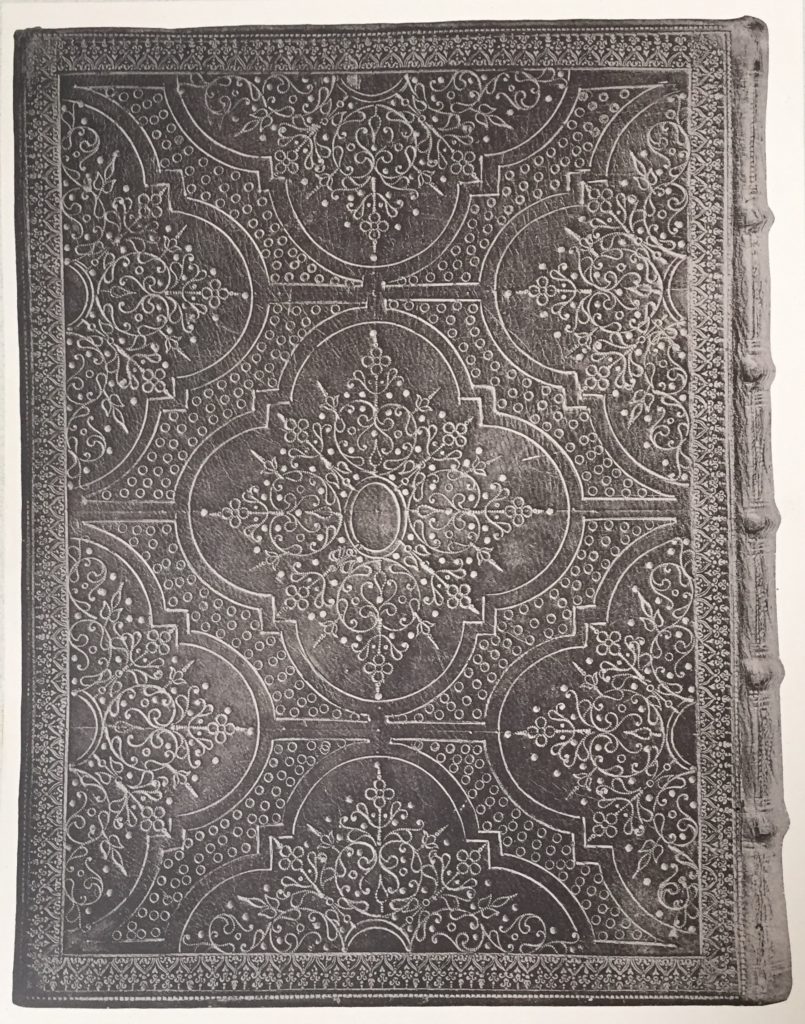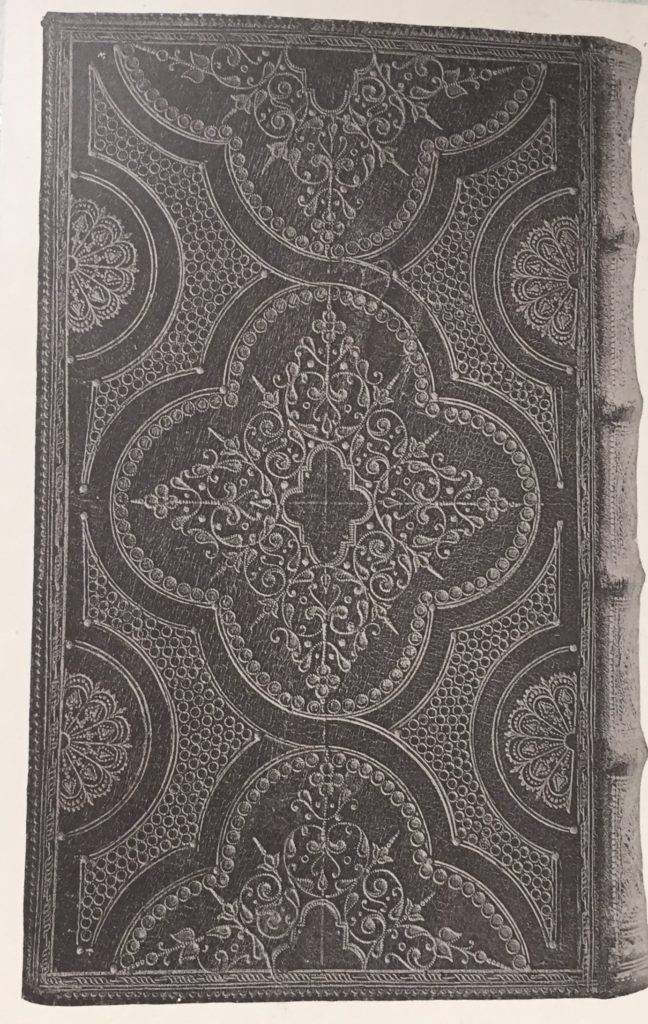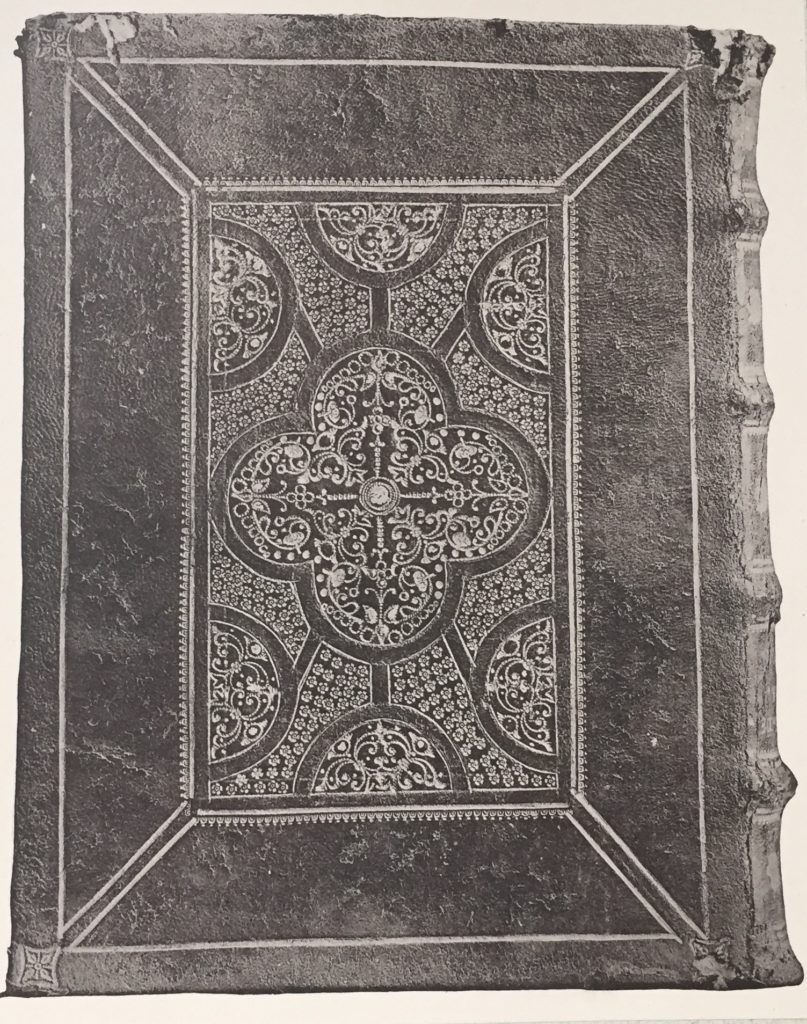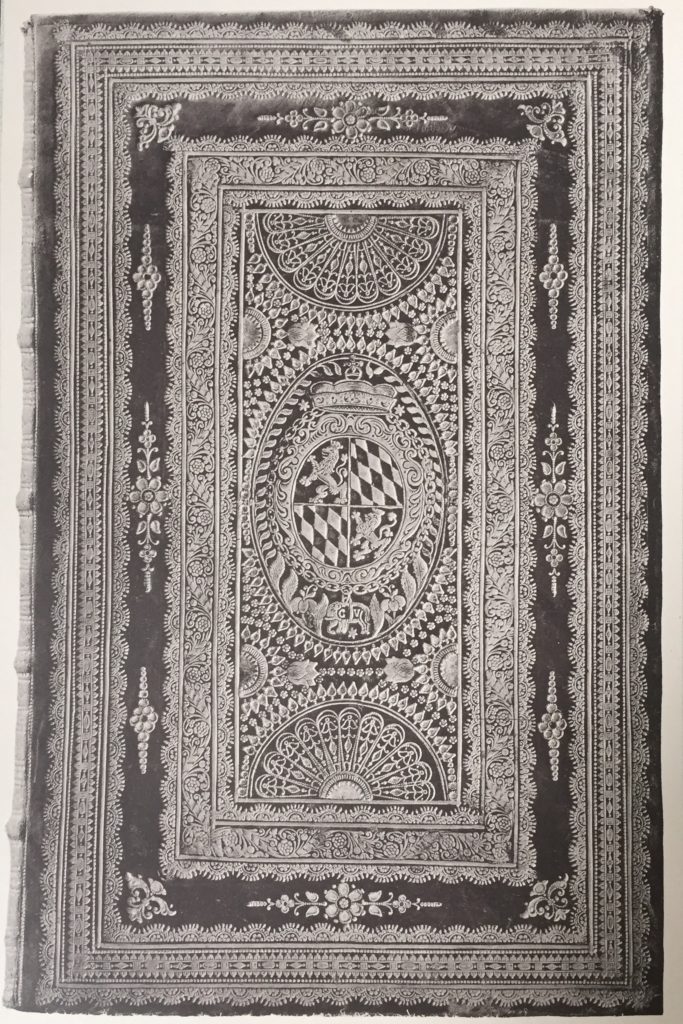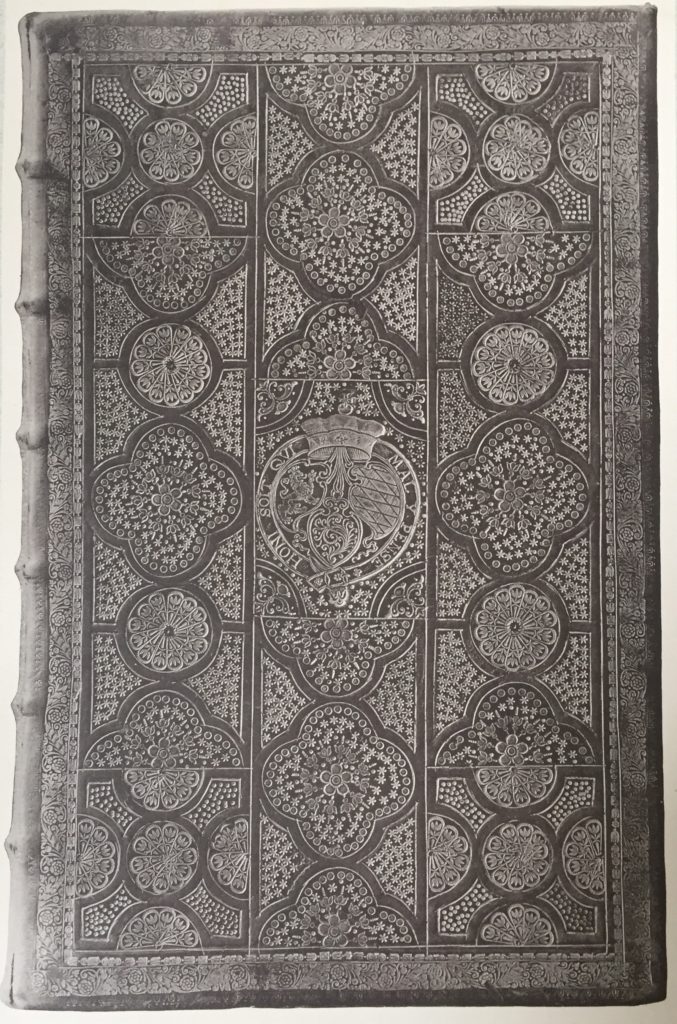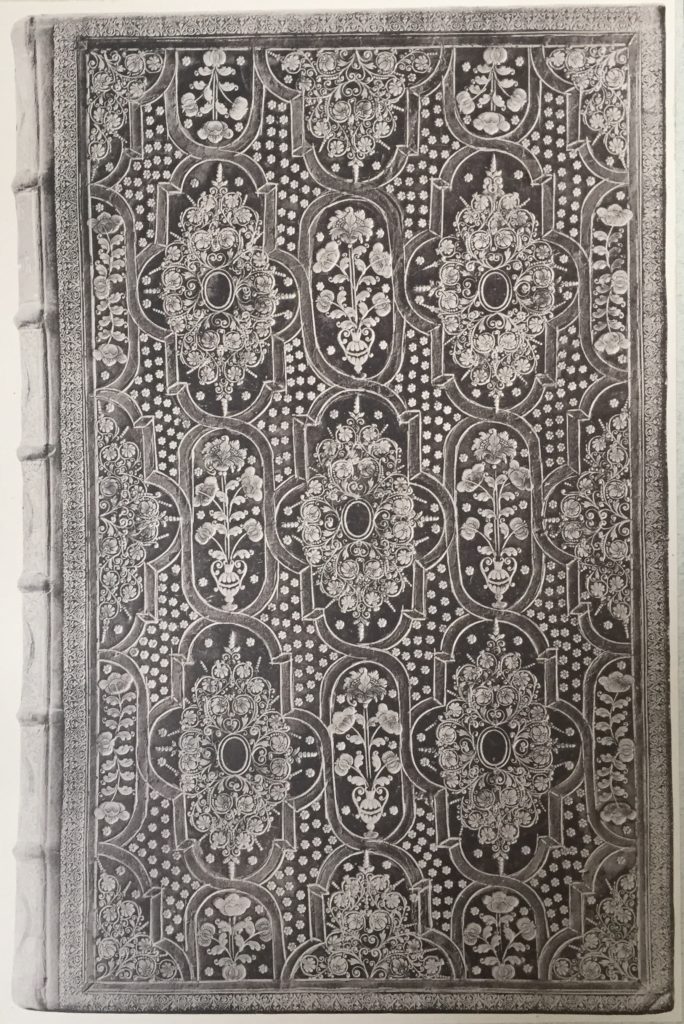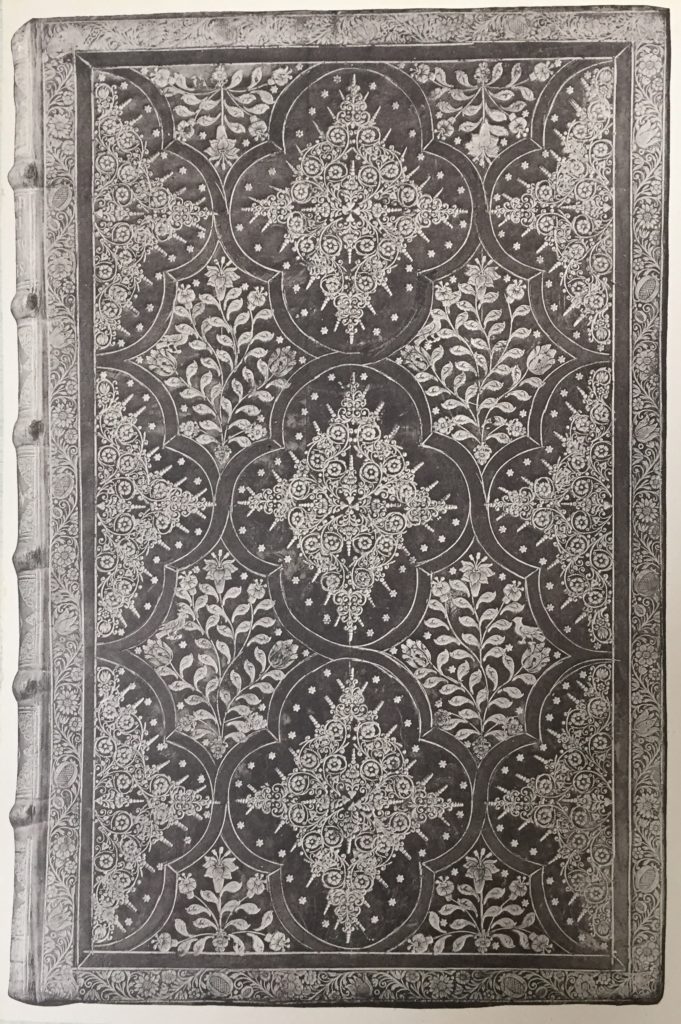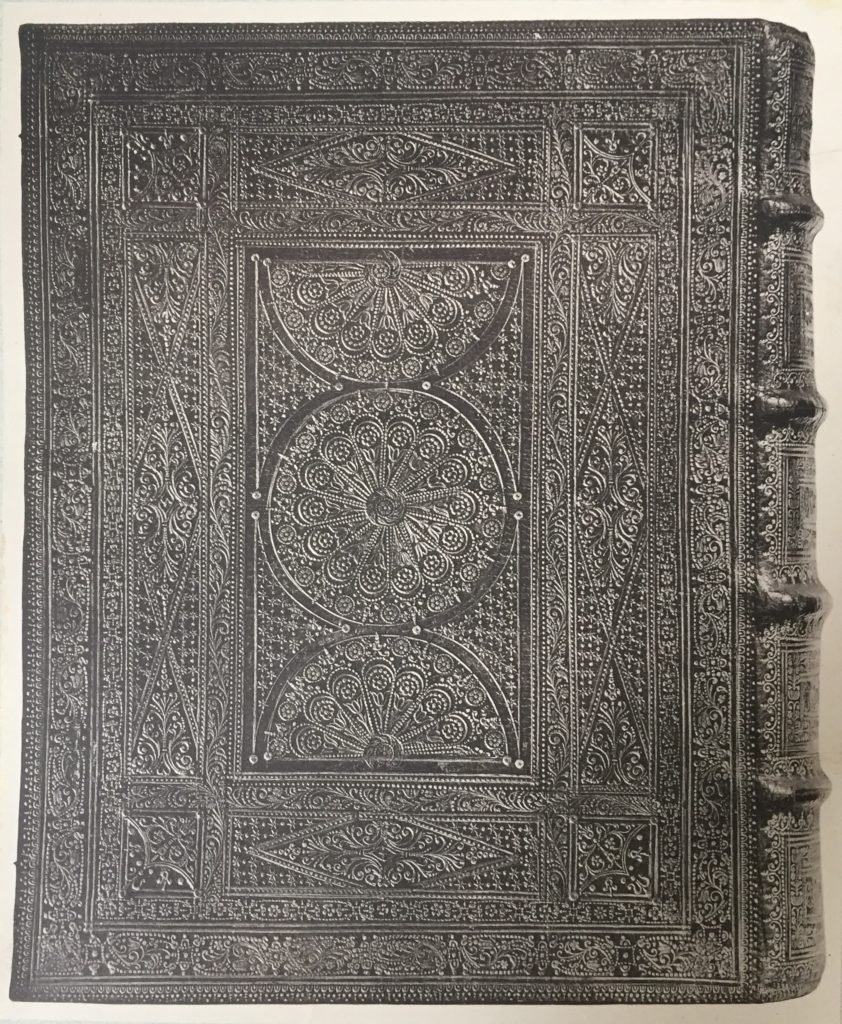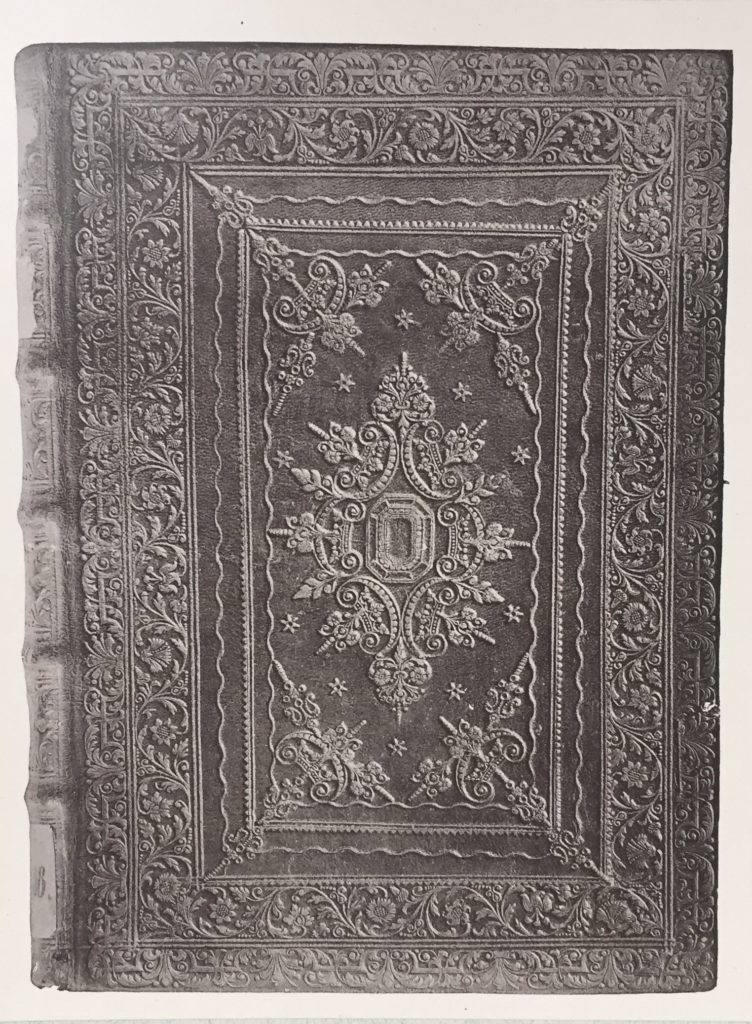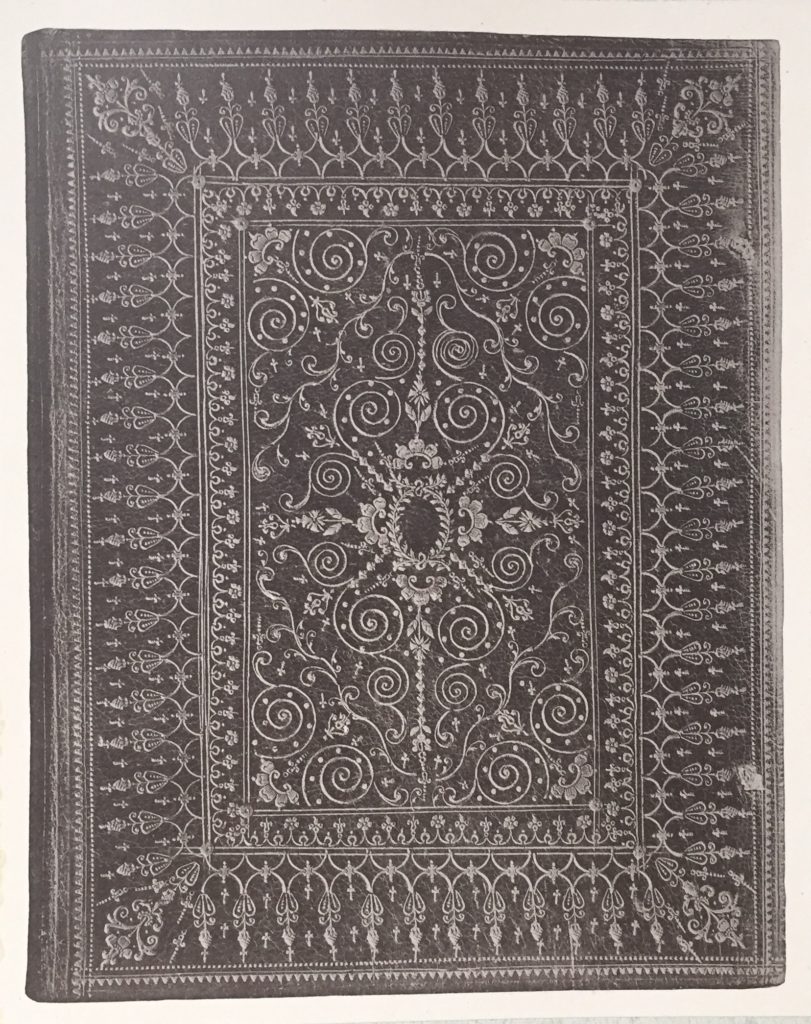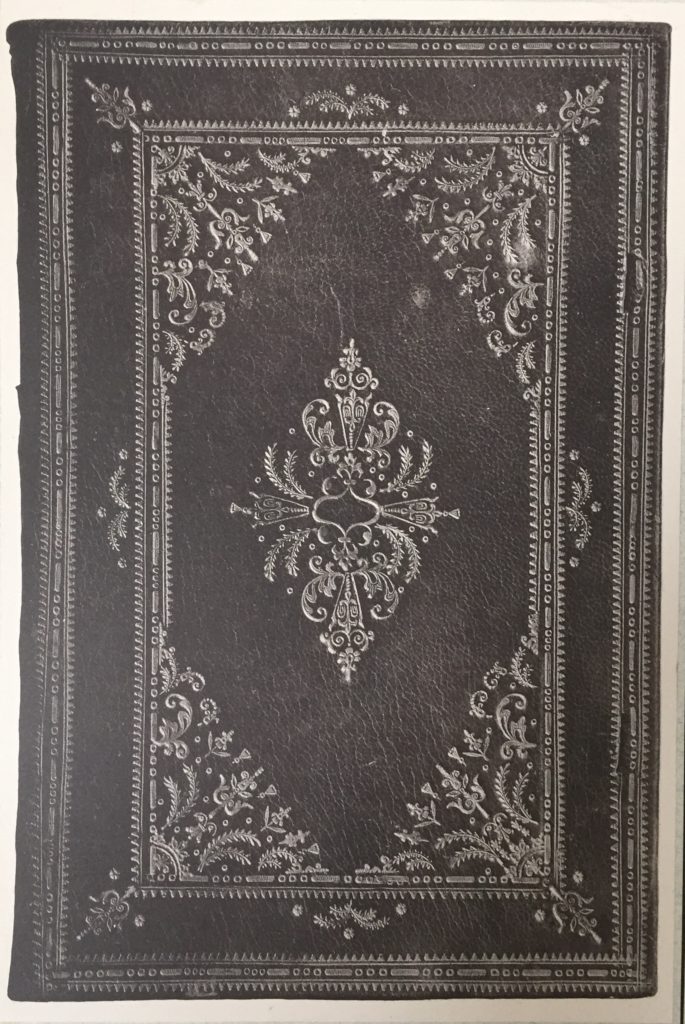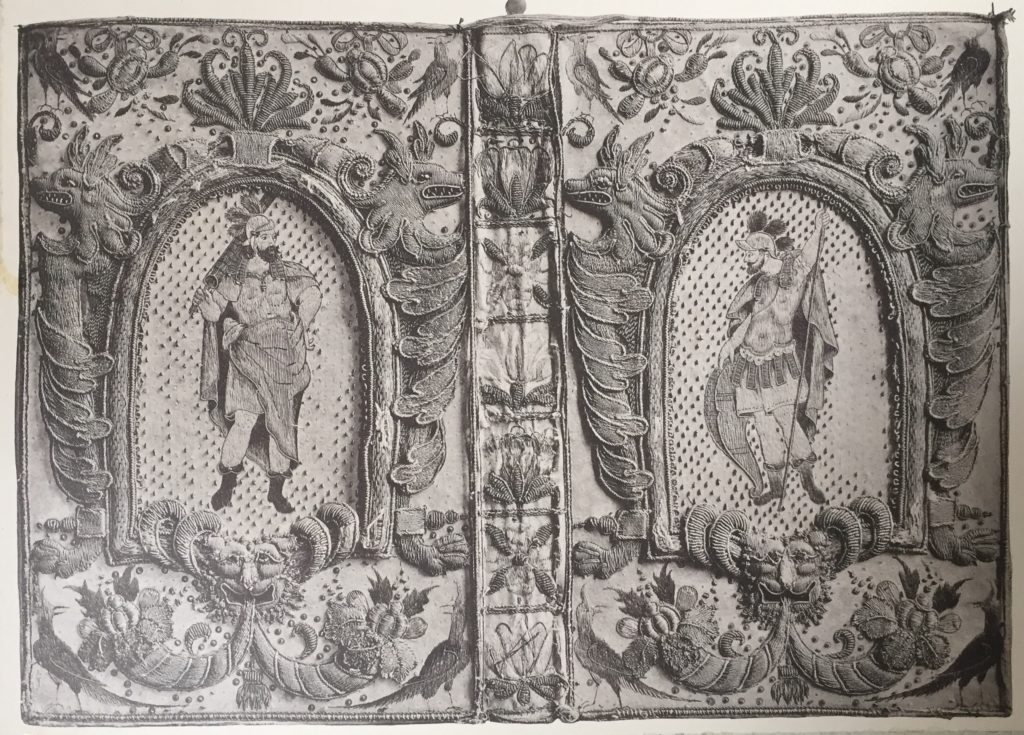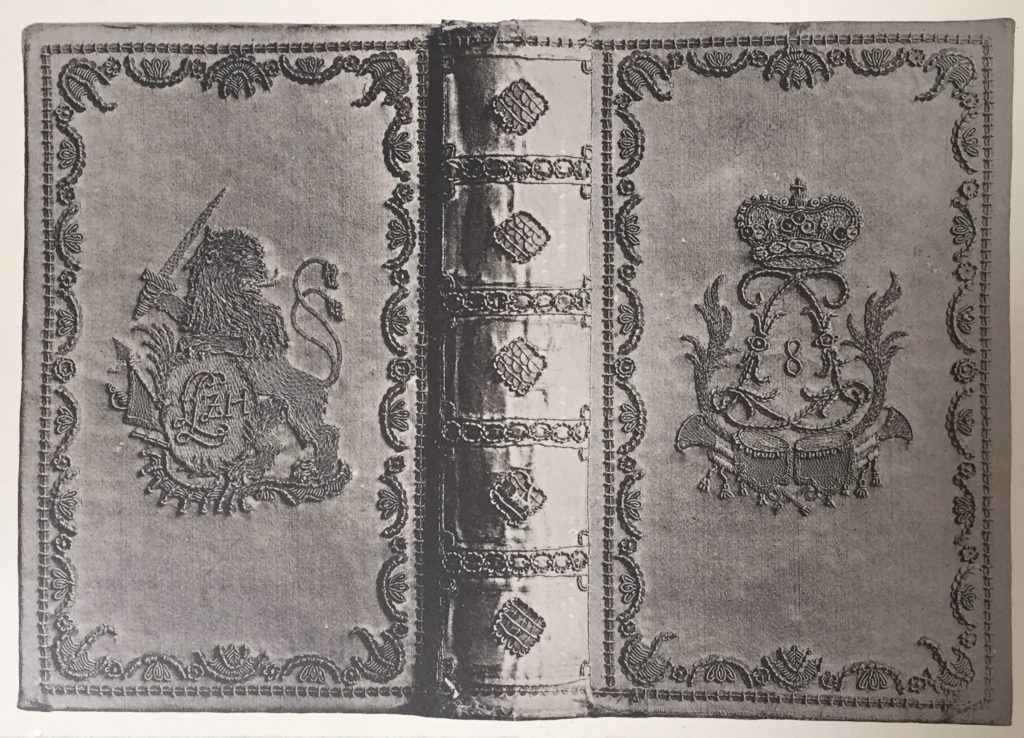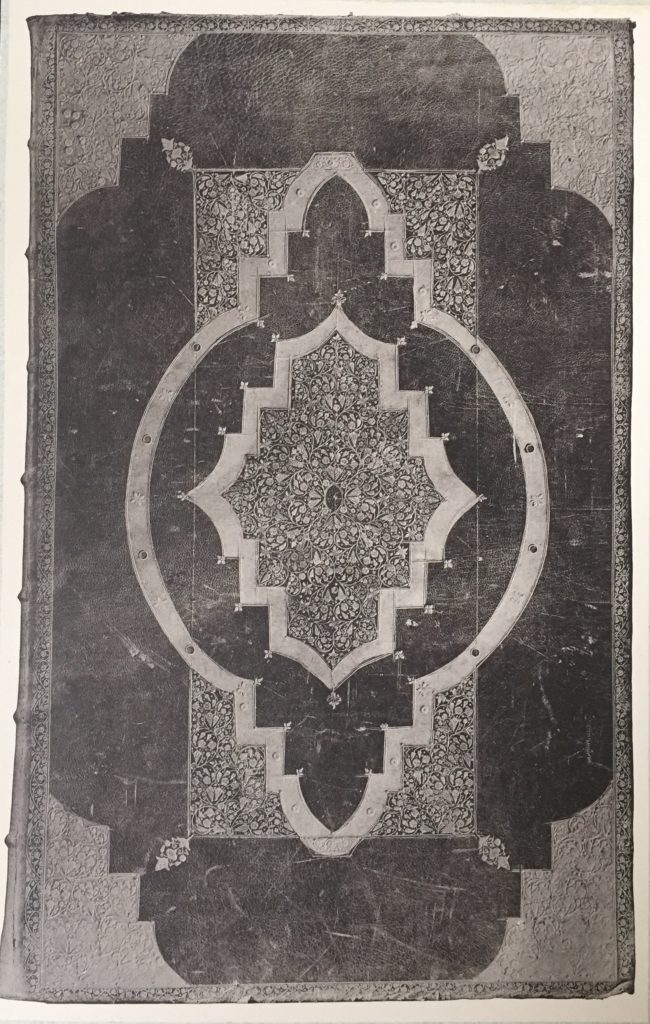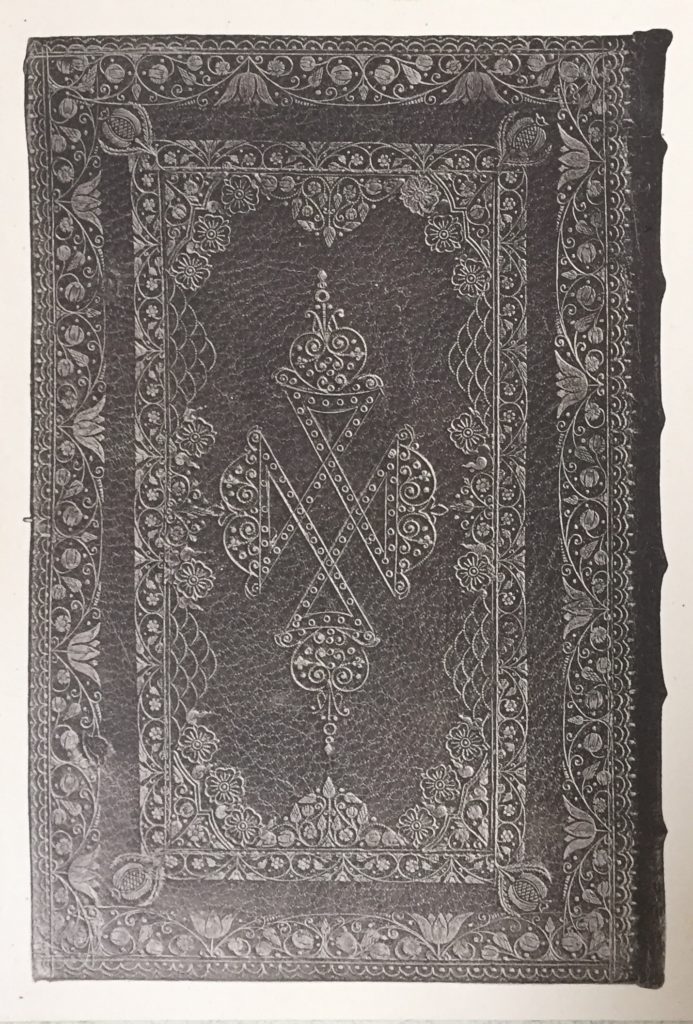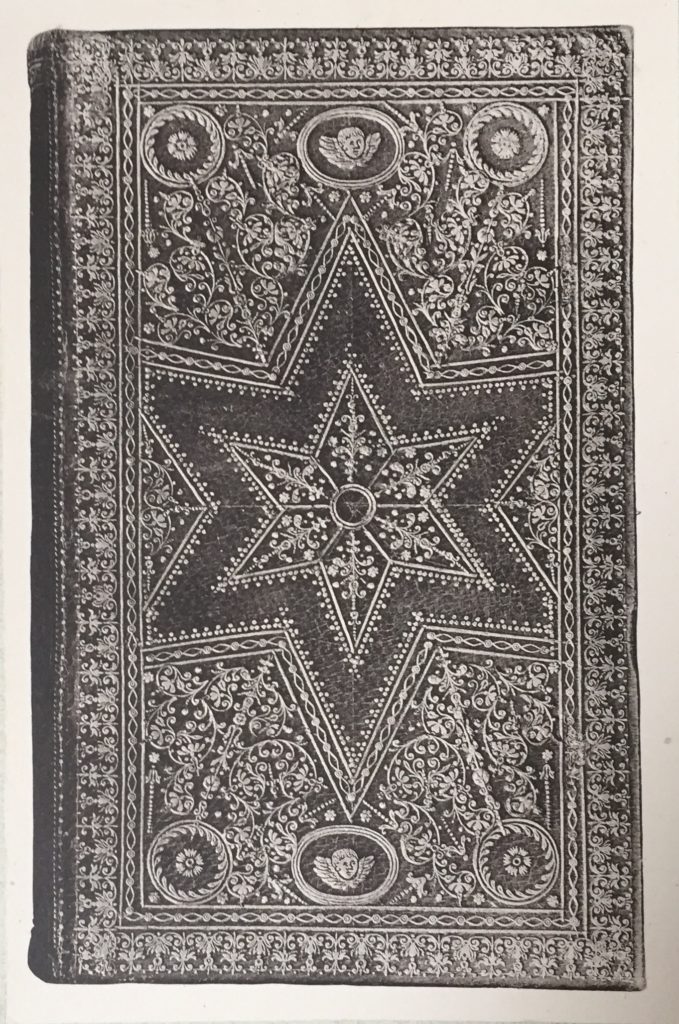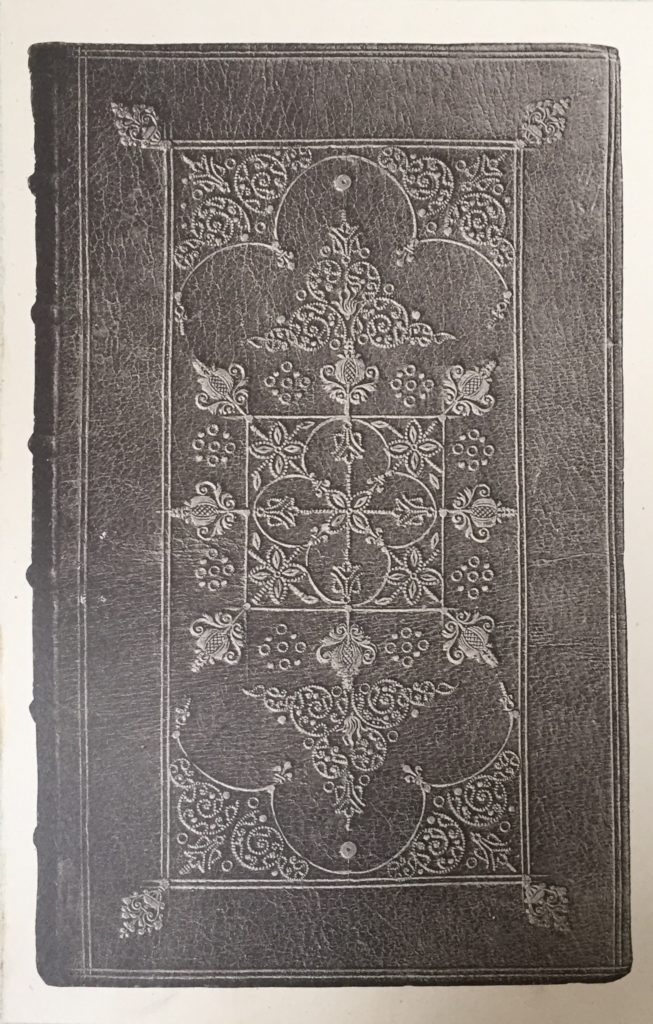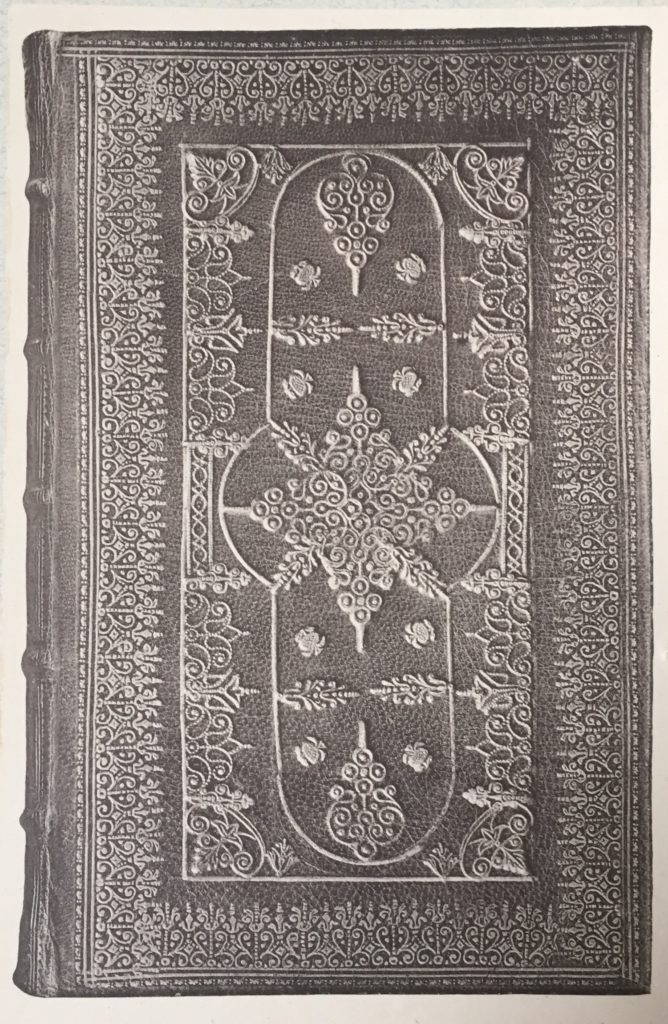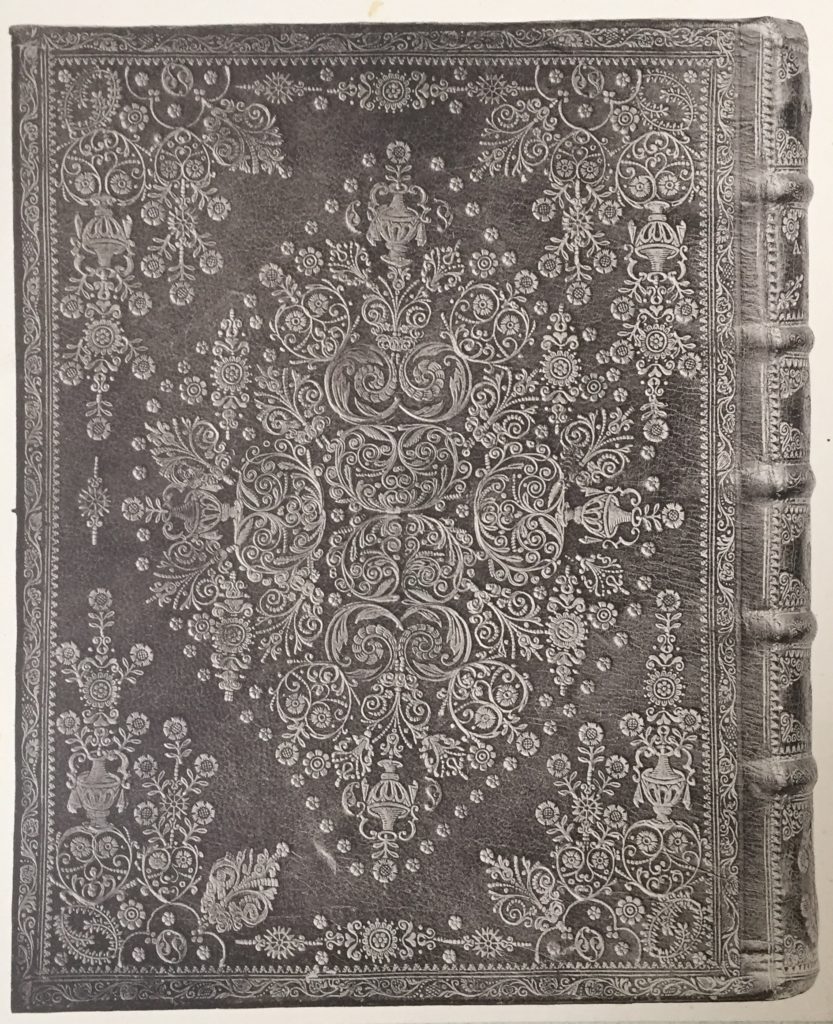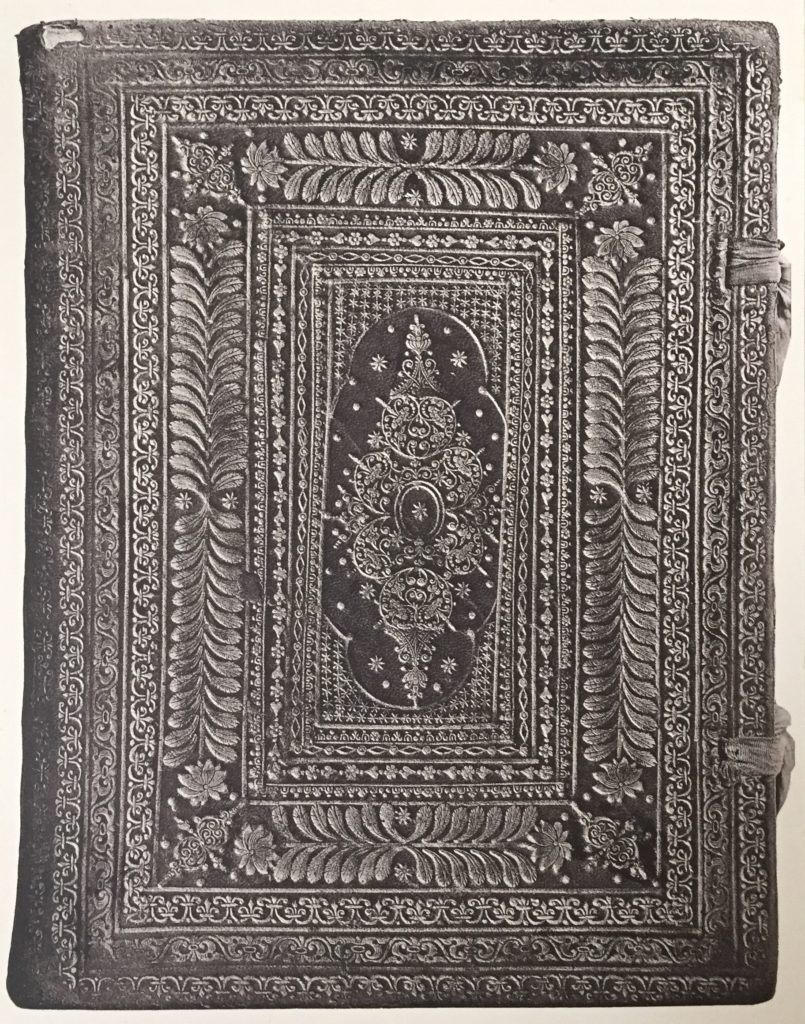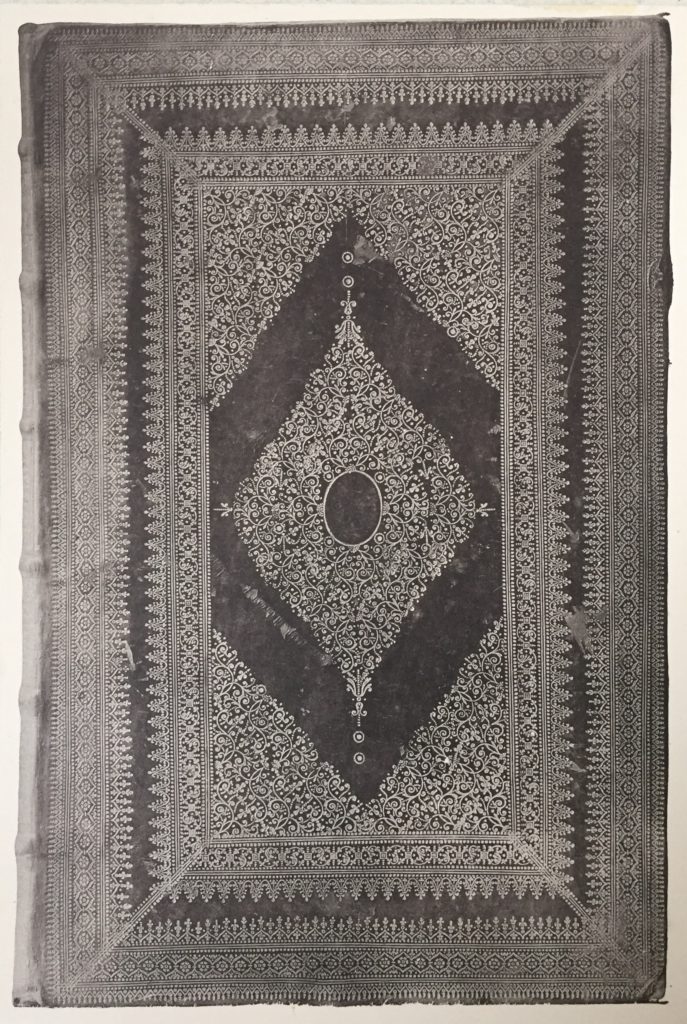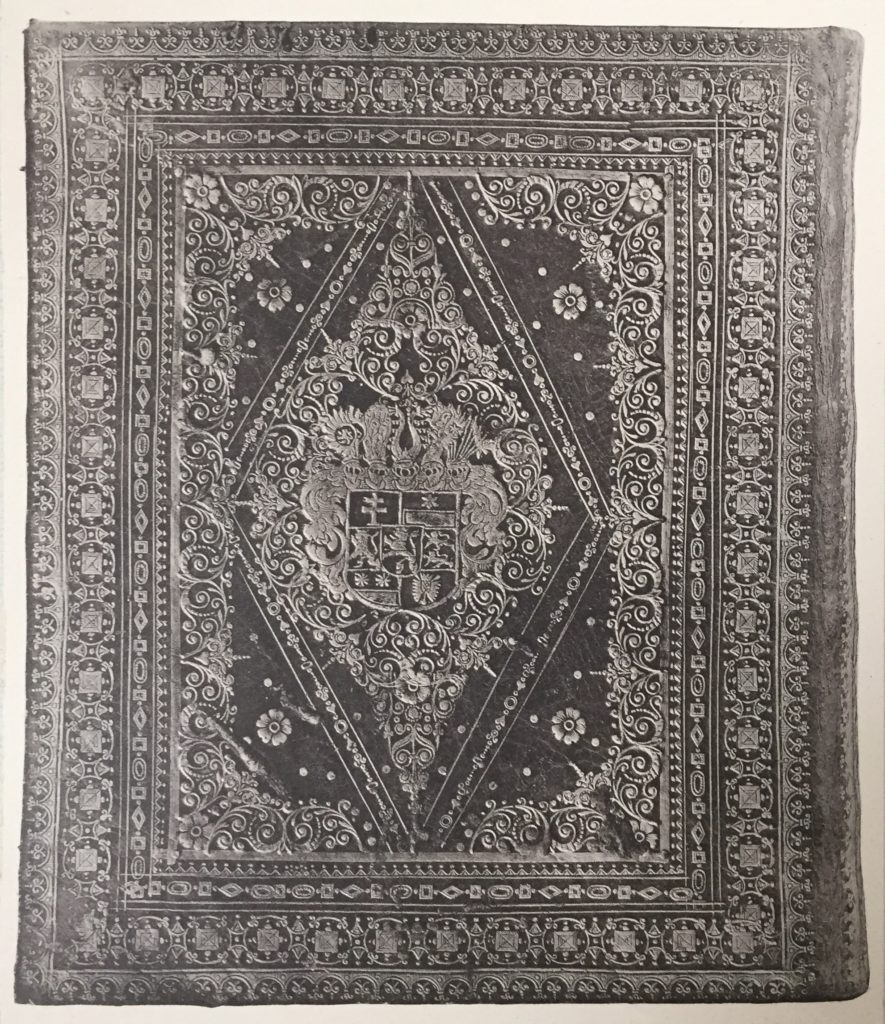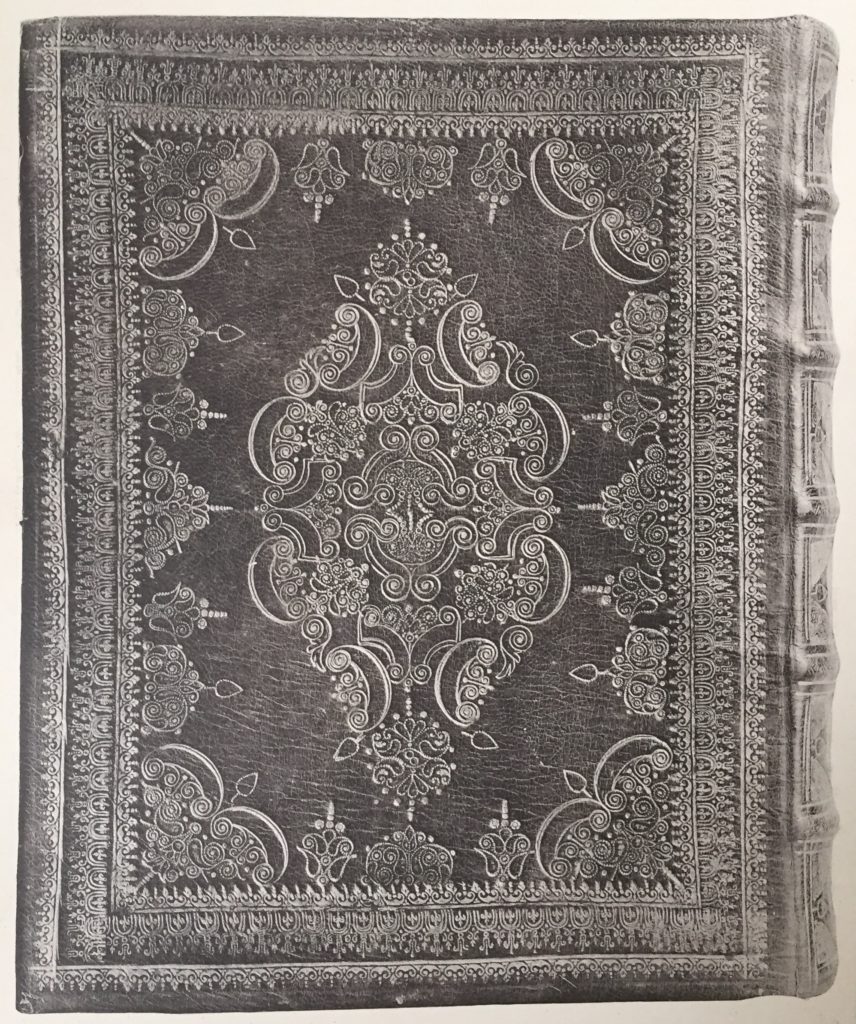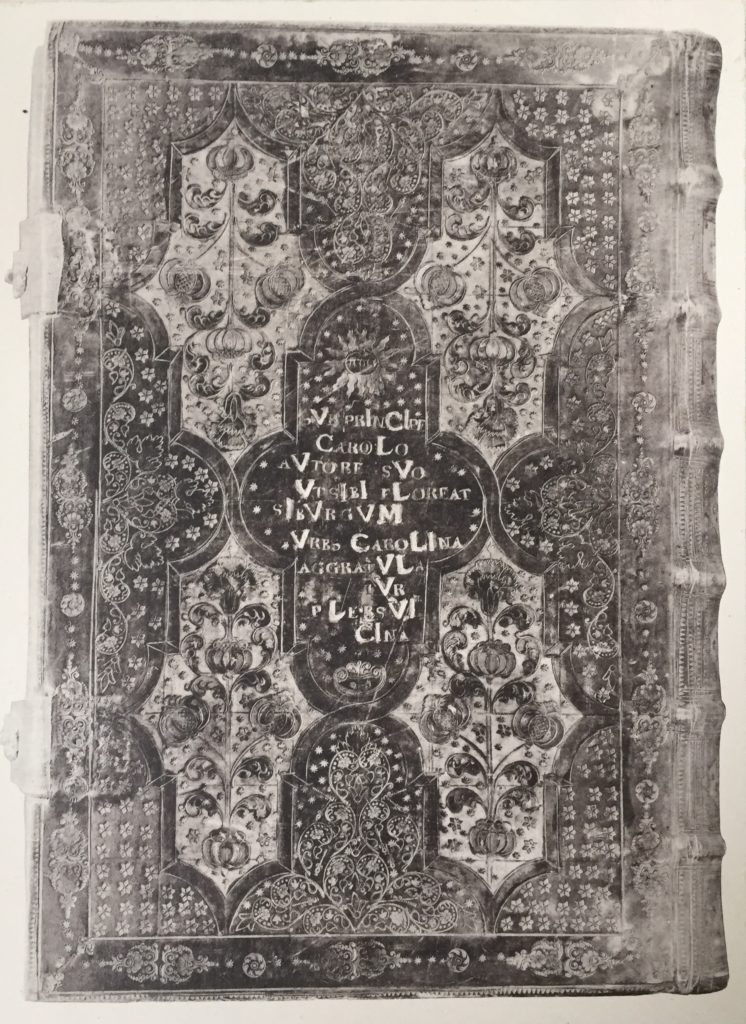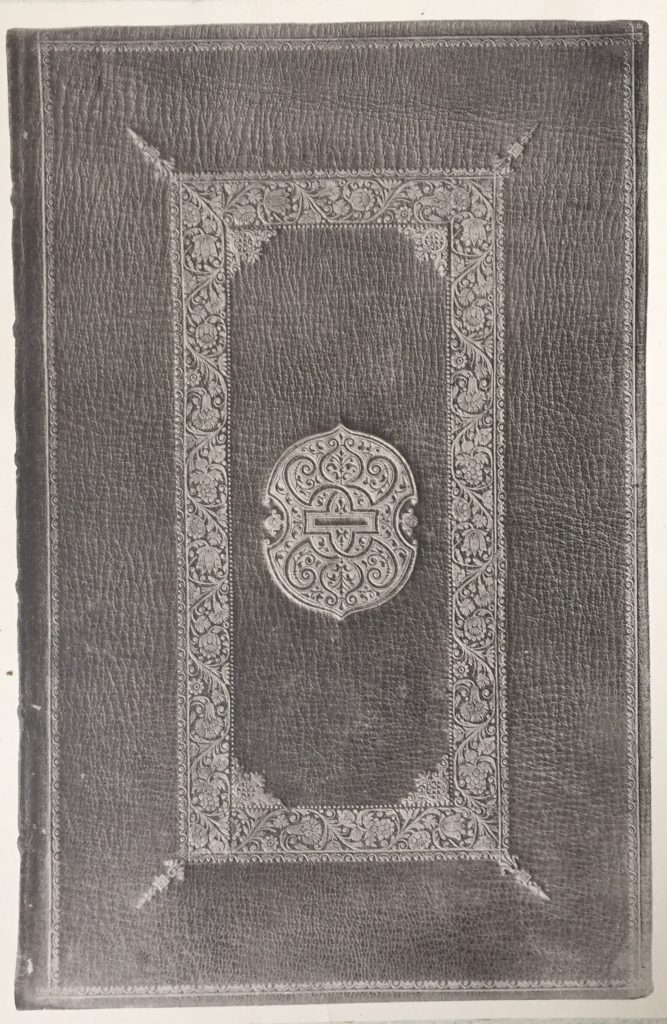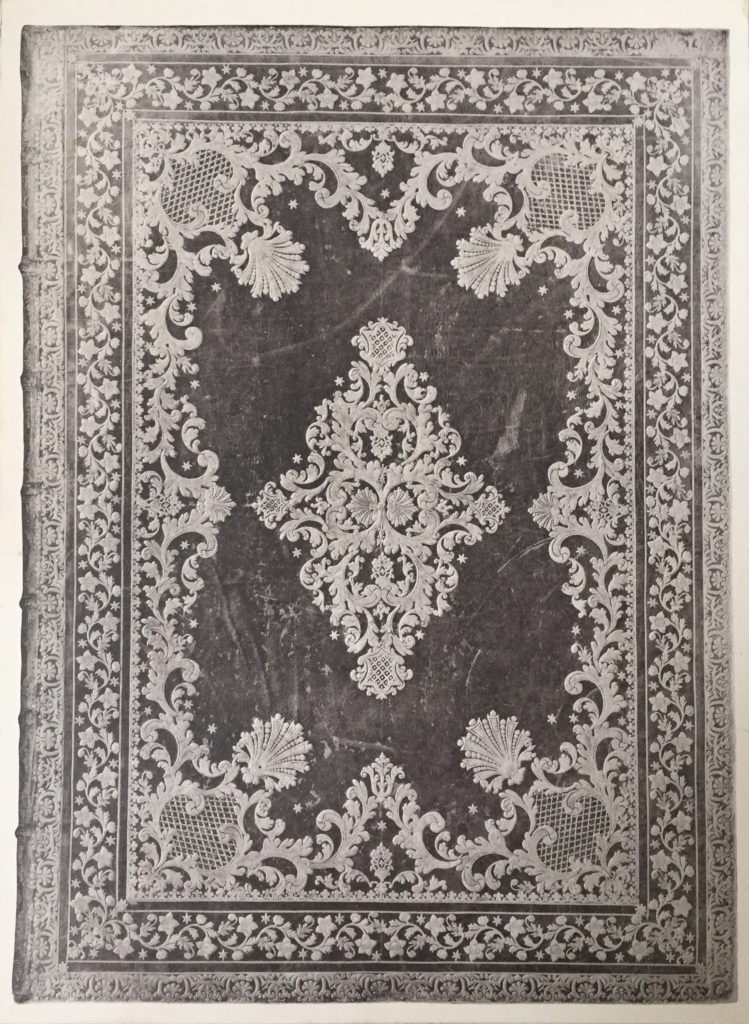BOOKBINDINGS
FROM THE
HESSIAN HISTORICAL EXHIBITION
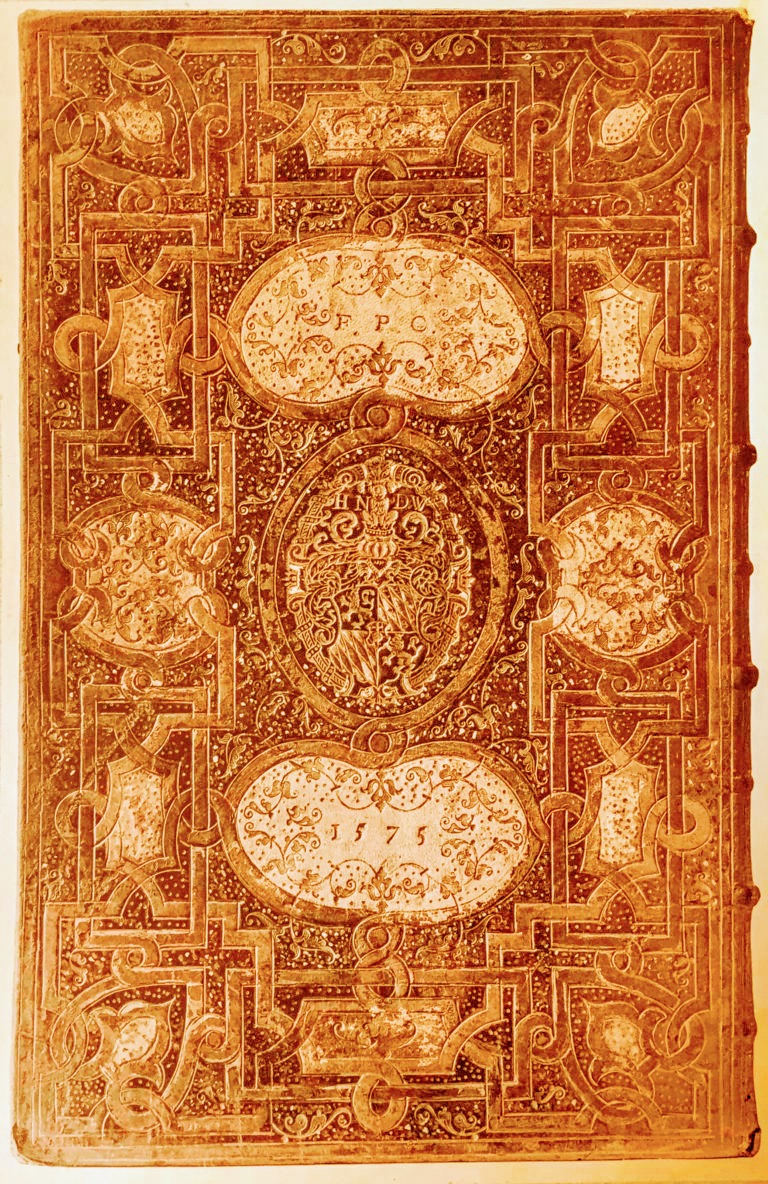
ILLUSTRATING THE ART OF BINDING
FROM THE
XVTH TO THE XVIITH CENTURIES
DESCRIBED BY
DR L. BICKELL
WITH 53 HELIOTYPE PRINTS ON 42 PLATES
1893
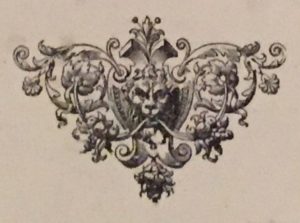
OF THIS ENGLISH EDITION ONLY ONE HUNDRED NUMBERED COPIES ISSUED
No. 29.
A NEW EDITION WILL NOT APPEAR, THE PLATES HAVING BEEN DESTROYED
AND THE TYPE DISTRIBUTED.
The Jubilee Exhibition of the Hessian Historical Society at Marburg in the summer of 1890 included not only books printed in Hesse , but also the most valuable bindings, from a historical, technical or artistic point of view, to be found in the more important public libraries of the country. A welcome opportunity was dills offered to the present writer to examine the libraries in Marburg, Cassel, Fulda and Giessen for such bindings.
The great object of this branch of the exhibition : that of furnishing a reliable basis for a future “History of Bookbinding in Hesse”, was satisfactorily attained ; and with a view to fixing the results and further pursuing the investigations, more than half the volumes exhibited were photographed by me and a still greater number accurately described. It soon turned out, however, in the course of the work that the greater part of the bindings exhibited were not of Hessian origin, and that it would therefore be desirable to make these treasures, so important for industrial art, accessible to a larger circle of amateurs. It may not be out of place to give here a brief sketch of the history of the libraries in question, compiled from much scattered material.
THE STATE LIBRARY (LANDESBIBLIOTHEK) AT FULDA.
Fulda is the cradle of civilisation in Hesse. Soon after its foundation by men like Rabanus Maurus, Walafried Strabo and others, there arose here a far-famed monastery school, which sent forth, century after century, a long series of priests, scholars and statesmen. A flourishing scriptorium, which cultivated the decoration of books with illuminated letters and miniatures and artistic bookbinding, created and maintained a copious library, long renowned as the most important in Germany, and assiduously used by popes, bishops and scholars. After the invention of printing, there arose by the side of this collection of manuscripts another of printed books, which also enjoyed the reputation of great value.
Of tile first division, unfortunately, as good as nothing is now to be found in Fulda, but at least one catalogue of it, dating from the 16th century, was discovered and published by Kindlinger in the beginning of this century. Over this total disappearance scholars have pondered long without coming to any tangible result, the archives having, till now, thrown no light on the matter. There is evidence that at a very early period the collection of manuscripts suffered severely from that laxity and negligence which were then only too common. It is probable that at the visitation of the abbey by Cardinal Carafa in 1627 the greatest part of the library of manuscripts was carried off to the Vatican Library, where, as a matter of fact, codices from Fulda have from time to time been found. Further losses occurred during the rebuilding of the abbey at the beginning of the last century. It was not till 1770 that the erection of a new library was begun: it was completed in 1776.
The ground floor was intented For the extensive archives while the library was housed on the upper floors, and particularly in a large hall, round which ran an estrade fitted with tastefully carved book-cases, desks and niches, the whole giving evidence of the skill with the architects of those days knew how to com bine comfort with noble elegance. The library of the priests seminary possesses a similar arrangement.
The present library arose out of the relics of the former one, and received a most valuable addition in 1803 in the por- tion of the library of the Monastery of Weingarten (in Swabia) which fell to the share of the Prince-Bishop Wilhelm von Oranien.
Of bookbindings it contains, in addition to those shown on Plates VI, VII, X B &c., the remarkable Bonifatius Bible, an antiphonary and a small prayer book bound in silver filigree. These were not exhibited and are to be dealt with in a supple- ment. Numerous incunables are of interest for the history of mediaeval blind tooling with small stamps. The 16th century is fairly represented by some striking blind toolings from Wein- garten, the 17th century by Low German and South German gold toolings with naturalistic flowers, coats of arms &c. Fine bindings in the French or German variations of the Grolier or Le Gascon type are entirely wanting. One of the better spe- cimens, probably from Cologne, is given on Plate XXXVI.
Next to Fulda, the Hessian monasteries which displayed the greatest literary or artistic activity were those ofTritzlar, Hers- feld and Helmarshausen, but those of Kaufungen, Wetter, Haina, Hasungen, Schliichtern, Amoneburg and Marburg also possessed libraries of greater or less extent, and the rest’ must at least have possessed a few noteworthy liturgical books.
MARBURG UNIVERSITY LIBRARY.
The selection seems, unhappily, to have been very one- sided, for of specially liturgical works, which we should naturally expect to find richly bound, not one escaped destruction. The parchment codices seem, like the church vessels, to have been applied to a more ‘rational’ purpose: in this case to bin- ding books and wrapping vouchers, round which many a piece of parchment, illuminated with splendid initials, is still to be found. As might be supposed from its origin, the library of the University of Marburg is unusually rich in incunables and in works of the 16th and 17th centuries purchased for the require- ments of the University and bound in the styles of those periods. Want of means happily prevented the introduction of that uni- form rebinding which had such ruinous effects in large, wealthy institutions. University binders are mentioned at an early date in the annals of the University, and it is not difficult to find out which works were bound by these officials.
Here, too, large donations and purchases of a later date have caused many a foreign binding to find a resting-place. For us, however, the most important acquisition was the transfer of the incunables from Corvey, Hoxter, Bursfelde by Jerome, King of Westphalia. Among these are numerous works intended for the daily use of the clergy and scholars. The books are of small size, 410 and 8,0, and bound in a practical, light, limp cover of simple pig parchment with a string or centre clasp. Many of them, too, have not improbably retained the provisional wrapper the forerunner of the later paper cover — in which they were issued from the press. The method of sewing employed is remarkable and has not hitherto been described. Without entering into details here, I should also like to draw attention to the volumes from the monastery of the Brethren of the Common
Life, which show a peculiar method of sewing, similar to that described under Plate VIII. The appearance on all the volumes of the same tools or sets of tools (identical subjects in different sizes) the plain imprint: liber fratrum domus Rivileonis in Marburg (i. e. “of Lewenbach”, as may still be read on the building of the monastery) along with the notice in the archives that the Brethren did binding for themselves and for customers, furnish abundant proof that these books came from the Brethren’s. workshops.
GIESSEN UNIVERSITY LIBRARY grew up in a similar way to that of Marburg. It originated in a collection of 1342 works bought in Strassburg in 1612. Half of the library then existing in Marburg was added in 1627 in accordance with a compromise which settled the question of inheritance. A number of important donations and purchases followed, but it was above all the incorporation of the old library of St. Mark’s in Butzbach which brought additions valuable from our point of view. Giessen accordingly possesses a large number of incunables in their original bindings, representing a rich variety of types from all parts. The 16th century is represented by a number of interesting blind toolings. Fine bindings of this and the t7th century seem to be entirely wanting. The Wurtemberg binding, Plate XVA, is the only one of such richness that I have observed.
Richer in remarkable and beautiful bindings than all the others put together is the STATE LIBRARY (LANDESBIBLIOTHEK) AT CASSEL. This library was established by the Landgraf Wilhelm VI the Wise, who systematically enlarged to a library of general science the old princely collection which had previously only reflected the practical needs and the passing tastes of the Landgrafs. Many old heirlooms are still preserved in it, such as the valuable illuminated manuscript of Wilhelm, written for landgraff Heinr Landgraich II. (the Iron). Under Moritz the Learned many an undoubtedly rich and remarkable binding was unfortunately lost. In the place of these we now find a plain calf binding with roll border and a scanty Hessian coat of arms in the centre. (On the back is the coat of the librarian Thysius.) Another heir- loom is the “Ritterspiegel” depicted on Plate III. That the Landgraf Philipp, the father of the founder, possessed a small hand-library, chiefly devoted to history and military science, is proved by the books I have found decorated with original gold tooling on calf with rich coats of arms and a variety of rolls and small tools, all of good design. The oldest volume is dated 1543; one of the rolls, well engraved in Holbein’s manner, dates from 1539.
Wilhelm IV. attached value to a fine binding, without, however, sharing the luxurious taste of other courts. He had his own court bindery (from 1591 bookbinder Meyer), but he also bought at the fairs. His bindings are mostly excellent polished calf, decorated with gold and blind tooling, partly with the inherited blocks, coats and rolls, principally, however, with new tools. Less common are the ordinary white sheep bindings. It is impossible here to give even a summary of the results arrived at, to describe the types which were developed under him and his son Moritz within the limits of mediaeval blind tooling. important, too, for our purpose was the lively exchange of new works of the Reformers which was kept up with Saxony, Wurttemberg, &c., and brought much that was beautiful to Cassel.
Original, but without influence on later binding, is the pierced and underlaid parchment binding shown on Plate XIX. Binders might still avail themselves of this idea, though perhaps only for books that are not to be much used.
With the establishment of a printing office in Cassel after 1600 by Wilhelm Wessel, the number of bindings which may safely be attributed to Cassel increases also. In the decoration of these volumes the effects of Dutch and French influences may alike be observed, not merely because the taste of the court favored partly the one, partly the other style , but principally because the bookbinders were recruited from the religious refugees from France, so that one is not surprised to find the attempts of beginners beside the finished performances of masters, and badly engraved imitations of tools beside others of classical elegance.
The most important and extensive addition of magnificent bindings was that made to the library in consequence of the Palatinate inheritance in 1686. Carl Ludwig, the last Pfalzgraf of the house of Pfalz-Simmern, had bequeathed to the Landgraf Carl of Hesse the Court Library at Heidelberg (not to be confounded with the older Palatine Library which was carried off to Rome) which had been collected by himself and his father. After the disputes arising out of this inheritance had been settled by judicious negociations, this library, including that of some 4500 volumes which had been this library, including that of some 4500 volumes which had been left by Princess Charlotte of Hesse-Cassel , the consort of the Kurfurst, was brought to Cassel in the summer of 1686. It also contained relics of the old Court Library (for which it is well known that a special bindery existed under Otto Heinrich) in the characteristic, well preserved calf bindings embossed with blocks and rolls.
These newer accessions are bound in the style of Le Gascon-Badier, enriched, however, with a number of new and original designs. The blocks with the coat of arms of the Palatinate ; the end-papers of a style that was never used in France; the uniform binding of books from all manner of printing offices, are proof that the volumes were bound in a Heidelberg bindery.
On this point the Grand-Ducal archives, unfortunately, afford no information, the documents having probably been destroyed in the great fire of the castle. The circumstance that only scattered volumes decorated in this style, among them, in particular, those volumes decorated in this style, among them, in particular, those which were retained as referring specially to the history of the Palatinate and Bavaria, are to be found elsewhere, has hitherto kept in obscurity this bindery and this style , so important for the history of bookbinding in Germany. The inducement to introduce the Le Gascon-Badier style. which I should be inclined to call the ‘filigree’ style, into Heidelberg, may perhaps be found in the marriage of the sister of the bequeather, the well known. in the marriage of the sister of the bequeather, the well known Lieselotte, with Philip I. of Orleans. At the time of the transfer of the Palatinate library a catalogue was compiled which still exists in Cassel, marked Mscr. litt. fol. 5, and enabled the provenance of the books to be definitely ascertained. The provenance of the books to be definitely ascertained. The catalogue marks are given with each volume photographed. Later on, a catalogue of the private library of the Pfalzgrafin was also brought to Cassel and is still in the archives of the library. Later rulers steadily enlarged the library and adorned the books in the styles of their times. Material of the best quality, gilding of noble simplicity with borders and centre-pieces, frequently with coats of arms, are the leading characteristic.
Interesting, too, are some volumes with rich rococo scroll-work, brought from Italy by the Landgraf Friedrich II, (cf. the last plate). Still later on, under Jerome Napoleon, the number of incunables was greatly increased by accessions from the confiscated libraries of Westphalian monasteries.
On its establishment in 1580 the library was kept in one of the rooms of the princely Chancery, which was connected with the castle by a gallery. In 1585 it was transferred to the new mews opposite the castle, and on the erection of the new museum by Landgraf Friedrich II. the library was moved into the upper story of that building where it is still housed. Originally it only occupied one large hall which took up the whole of the main wing. The hall also served, according to the taste of those times, for the exhibition of other works of art, mathematical instruments etc.,
MARBURG, March 1893.
Dr. L. Bickell.
Plate I.
EVANGELIARIUM, Manuscript on vellum
with pen drawings, XI centuryCassel, Ms. theol. fol. 60 (the Monastery of Abdinghof near Paderborn.)
Paul Clemen (Studien rue Geschichte der karolingiscben Kunst) attributes this EVANGELIARIUM ms to the scriptorium of Fulda, in which he thinks Anglo-saxon influence and the style of the golden age of Carolingian art may be traced down to a late period, among others in the drawings this codex (Jaisitchek, Repertoriuns d.Kunstwissensch 1890. [Vol.III] 134 seq. According to Browerus (Antiqq Fuldenses p 295), Scotch monks were invited to Fulda by Abbot Ricardus (1019-1039) and these may also have had some influence on the style.
Leaf Ib contains a hint of the treasures of the church of Abdnighof in the XI. century, and the following leaf list of later date.
Binding: Split beech boards covered with cochineal red chamois leather: 260, 200, 70 mm.
On the front side lies a thick, gilt brass border, the corners of which are adorned with bosses of rock crystal in separate settings and underlaid with blue vellum. In the centre of each side of the border a rose is riveted, the Inner petals being silver and the outer red enamel. The edges of the cover are protected by a metal strip decorated with tiny roses which serve as a setting for the heads of the nails.
Within this frame, which is vigorously engraved, are two ivory tablets, These contains saints who cannot now be identified and two angels, Michael and Gabriel, whose names are still faintly traceable in red Greek letters, Glories, emblems and palls of the angels are gilt. Above and below the tablets runs an obviously . contemporaneous fillet of ivory On removing the tablets it appears that the fillets are affixed by ivory pins to an underiying support between winch the tablets revolved on brass pivots.
This now useless arrangement was originally, no doubt, not without a purpose, and may be explained without difficulty if we assume the tablets to have formed part of a triptych. The backs of the tablets are adorned with a cross and show marks of the former fastening-. and a rabbet.
Almost exact repetitions of our tablets are to be found In the collection at Maihingen and in the treasury of the Cathedral at Aachen (cf, Bock. Karl d. Gr. .Pfalskapelle zu Aachen.Tab. 26 and 27). Here. too, a broad tablet has been preserved, which must have formed the central relief belonging to the wings. Little or no attention has hitherto been paid to the backs of the ivory reliefs on bindings and the traces of their former connexions. It would probably turn out that they had, in many cases, been taken from diptyches and triptyches which were no longer put to practical use for movable altars Ste., and are still preserved in the church treasuries.
To judge by the style the brass border belongs to the second half of the 15th century when the Evangelarium was rebound. The ivory tablets, of delicate work and in good preservation are probably German imitations of a Byzantine original of the 12th century, such as were then popular articles of commerce. The codex was brought from Paderborn in 1773 along with other valuable manuscripts &c. by Raspe, the librarian of the Landgraf Friedrich II. (Cf. Zeitschr. d. Vereins f. Ness. Gesch. and L. 1883. p. 129.).
Plate II.
MS. OF THE GOSPELS of the XII. century.
Fritzlar, Church Treasury (cf. Catalog der Austellung in Dusseldorf 188o, No. 963b).
Binding: Oak boards covered with brown calf: 300, 200. 70 mm.
The centre, surrounded by a frieze of varied scroll-work of the 17th century, is occupied by an inlaid enamel tablet, 24o: 165, consisting of a frame in one piece, a centre panel and 4 narrow mitered strips which conceal the inner edges of the frame and lap over and secure the centre panel in its place. The plates are of thick copper gilt, engraved with quarter length figures and a group of the crucifixion; the backgrounds being filled in with dark-blue, lavender-blue„ green-blue, bright yellow and white champleve enamel. The colours are all faded and cracked. The sprinkling in the central group is worthy of notice. The engraving is stiff but firm; it is seen at its best in the drapery of the Virgin Mary. Interesting, too, is the symbolical reference of the two beasts — dragon and lion — which are fighting at the foot of the cross. The leonine verses round the inner margin of the frame are : MORTI . VITA . DATUR . VT . VITE . MORS. SVBIGATUR . HINC . HOMO . PERPENDAT . QVID . XPO. DIGNE REPENDAT
The emblems of the evangelists and the figures of the 12 apostles are furnished with the respectivet names. The colours of the enamel are not those of Rhenish champleve enamel; on the contrary, like the pedestal of a cross preserved in the same treasury, they are probably the work of some local factory: Fritzlar, Fulda or Helmarshausen, in which latter town it is well
known that “Rogerus qui et Theophilus”, the author of the Schedula Diversarum Artium, is believed to have lived.
Plate III.
( J. RODE) 1. Ritterspiegel (Knight’s Mirror),
2c. Rechtsbuch, 3. Treatise on the seven Liberal Arts
Manuscript on paper: date about 1400.
Cassel, Ms. poet. rom. 4° 8 (an old heirloom of the Landgraf’s Family).
The Ritterspiegel is in rhyme and contains instructions for the highest sociological and heraldic value how a true knight should be educated and conduct himself.
Binding: Oak boards, beveled all round and covered with dark brown calf. 210, 130, 6o mm.
The volume formerly had strings furnished with a hook at the ends to fasten into the eyes on the front cover. The ornaments, of original design, are scored and chased. The bosses are conical, turned brass nails. The method of sewing may be seen from the plate, the headband still retains its band of carmine red.
Plate IV.
MISSALE, Manuscript on vellum, of the year 1463.
Cassel, Ms. theol. fol. 13i (from the Chapter library, Fritzlar).
The following record of the origin of the book exists on leaf Ib :
Dominice incarnaciois anno millesimo | quadringentesimo sexagesimo tercio | dus ichas kirchain decan9 ecclesie fritzla | riensis hoc altare instituit et fierri fecit et | presentem labrum procuravit suis propriis expensis | In honorem omnipotentis . . .
On fol. 126bis after the vere dignum &c. is a whole-page miniature of no great artistic value, representing the crucifixion. Beneath the cross the founder is kneeling, attired in his robes of office with an ermine biretta and holding his shield in his hand. On the upper margin of the opposite page may be read in small letters: pace fredico adolffo, perhaps the name of the painter. The fly- leaves bear a list of later date, showing the estates and revenues with which this altar of S. John was endowed.
Binding: Oak boards bevelled all round, 395, 280, 80 mm., covered with beautiful dark chestnut brown calf. The boards are lined with vellum; the edges coloured greenish yellow.
Sewing: 4 double and 3 single cords. The thread only passes round the double cords, and the kettle -stitch is about 1 cm. from head and tail. The headband which is let into the boards, and covered with a linen thread, which is kept in place by a thread which passes through the kettle-stitch hole of every other sheet; it is also covered with carmine red thread.
The decoration, in blind tooling, is the same on both covers, except the shield, and is remarkable for the inscription impressed with type and for the bookbinder’s token: 3 awls on a shield.
(Cf. the next volume.)
Plate V.
LECTIONARY written on vellum, about the middle of the 15th century.
Cassel, Ms. theol. fol. 115 (from the Chapter library, Fritzlar).
Without any entry to indicate the exact date or the provenance.
Binding: Oak boards beveled all round, 455, 310, 100 mm., covered with dark calf. The bosses are now missing, clasps, as in the case of the previous volume, were never attached. Edges greenish, back smooth.
Sewing: 6 double bands of white sheep , the kettle-stitch band is also a plain leather band round which the thread passes. The headband is let into the boards, and covered with a linen thread, which is passed through and round each sheet about 8 mm. from the margin of the paper. A broad vellum strip still remains glued on the back and covers between every two bands. The strips at head and tail have been plaited into the headband by a red thread,
With the exception of the scored and punched shield, the ornamentation is identical on both covers. The scroll-work of the ground pattern has been done with a pair of tools, one right, the other left handed. Half and whole continuous scroll tools occur on other bindings also. The circular tool with yhs is identical with that on Plate IV, and the same binder’s mark occurs also on the painted shield.
Plate VI.
GUTENBERG’S BIBLE,
of 42 lines, Vol. I.
printed on vellum with magnificent painted initials.
Fulda A. 23.
Nothing is known of the former owners of this volume or of the place where it was bound, and there is no entry on the subject. It may, however, be assumed that such special copie were only printed to order and simultaneously bound in Mainz.
The Bible seems to have been at an early date in the possession of the town of Fulda, as an entry on the second fly-leaf of vellum records its donation by the town to the new Prince- abbot, Constantin von Buttlar:
Reverendissimo et celsissimo S. Sacri Romani Imperil Principi Ac Domino Domino Constantino Inclytae | Ecclesiae Fuldensis Abbati, Divae Augustae Archicancellario | Per Germaniam et Galliam Primati Domino Nostro Clementissimo | Hic Sacer Codex Humillime Oblatus Est A Senatu Fuldensi | Anno MDCCXXIII.
Above the dedication is the coat of the town, richly executed in colours, and on the first page the coat of the von Buttlar family.
Binding: Oak boards covered with fine brown calf, cast metal corners and clasps. 440, 320, 105 mm. Edges uncoloured.
Particularly remarkable among the various tools are the round medallions with interlaced patterns in thoroughly oriental style.
*Editor’s note, more on GUTENBERG’S BIBLE here
Plate VII.
NICOLAI DE LYRA postilla magna super Evangelium S. Johannis.
Manuscript on paper of the year 1471. Fulda Ms. Aa. 99.
Binding: Oak boards unbevelled, covered with bright rough tanned leather, 330, 230, 70 mm.
Nothing remains of the mountings except the acute-angled, punched and chased corners of brass plate.
Sewing: 4 double cords with a kettle-stitch band. Headband let into the cover and secured by a second thread in each sheet through the holes of the kettle-stitch.
Decoration: On the front as shown; the figure of S. Katharine was first stamped with a wood block and the surrounding background added afterwards. The block used is obviously one of those which were kept in the monasteries for pictures of the saints, impressions on dough or patterns for embroidery. (The technique is not correctly given in the Guide to the Exhibition.)
The back cover has a double border like the front; the centre field is divided into lozenges in the well-known manner. The outer border contains lozenges with double-headed eagles; the inner one leaves turned right and left, forming a foliated frieze, the lozenges of the centre field are filled with squares containing lilies, the two-headed eagles and dragons (of good design). The entire back cover is deformed by the impressions of apparently irregular, enigmatical lines which were there before the tooling was begun. These are simply the traces of the string with which the damp leather was held down against the bands after being glued on. The regular course was to lay boards on the book before tying up, but even then the beginnings of the impressions of the strings remained visible beside the bands.
This unavoidable defect was then, in truly mediaeval style, utilised as a motive for decoration by deepening and smoothing the traces with a fillet and concealing the ends with a tool (lilies or the like). This has already occurred on several of our plates.
Plate VIII.
HIERONYMI EPISTOLAE ET TRACTATUS.
Mainz (Peter Schoffer) 1740.
Marburg X1Xa A, 130 (formerly: Liber S. Thomae in Bursfeld.)
Hain 8553 (or 4 ?).
The first and last leaf are unfortunately wanting, but the identification of the book is beyond doubt.
Binding: Oak boards 13 mm. thick, unbevelled, 480, 335, 8o mm., bevelled at the back, except about 2 cm. from the ends which were kept entire in order to attach the headband. Covered with smooth, brown leather, the front of which shows the partly unfinished decoration photographed here.
Sewing: 5 double cords, between them 4 “blind” white leather bands. After the sheets composing the book -had been trimmed and were still in the press, a notch 7 mm deep was cut in the back at the places for the cords. Then, just as occurs in the oldest vellum books (cf. Catal. d. Einb. d. G. M. in Nurnberg), a beautifully uniform hemp thread, 0;4 mm. thick, was passed through these notches and carried over the marginof the magnificent strong paper round the headband and knotted to the latter. The headband was then sewed to the leather of the back in such a way that the leather projects 3 mm over the edges and prevents any displacement. It is possible that the sheets were again pressed and the edges scraped down before the back was pasted on over a layer of vellum strips and after the covers had been fastened on. Both the leather bands and the cords have been let into the covers and fastened with pegs; the former have all given way, the latter are intact.
The mounts are wanting, but were no doubt only hollow spherical nails.
The decoration is in plain outline without any modelling. The lines of the original sketch for the design, which seems to have been traced from a woodcut, are still recognisable, and are to some extent more artistic than those of the finished tooling. The back cover has a border of double lines with a centre field divided into lozenges. In these occur alternately round and diamond tools, representing roses, leaflets and stars, in all 5 different tools. The divisions and the position of the tools are correct, but, owing to improper damping of the leather and hea- ting of the tools, the impressions are unsatisfactory.
Plate IX.
DECRETUM GRATIANI, cum apparatu Bartholomaei Brixiensis. Basel 1486.
(Hain 7903.) Cassel, jus canon. Fol. 91.
Binding: Oak boards covered with brown calf, 420, 290, 70 mm. Acute-angled corner pieces and an embossed centre boss. The clasps have been replaced by smaller ones.
Sewing: 4 double cords with kettle-stitch; headband ‘fastened into the boards as usuaL
Decoration : on the front cover as shown; that on the back cover is simpler, consisting of a broad, smooth border and a centre field, divided by diagonals and transversals into spaces occupied alternately by the stag tool and small roses. The mounting of the centre and corners is the same as on the front side. Marks showing that the book was formerly secured by a chain. The panels of the back are also plainly ornamented. Among the tools that used for the pointed frieze is particularly interesting.
Plate X A
JOH. NIEDER (ord. Pred.) Preceptorium divine
legis venerabilis fr. . . Nurnberg 1496.
Marburg XIX c A 559d (liber St. Stephani et Viti in Corbeja).
Hain 11796.
The first and last leaves are wanting, but the old lettering on the back with oil-colour, “Nieder”, is still preserved.
Binding: Oak boards slightly bevelled all round, 235, 165, 5o mm., covered with bright, unpolished calf leather. No mounts except the clasps of unusual, pleasing form (the hooks are missing).
Sewing: 3 double cords and kettle-stitch. The headband, which has long since been torn off, was fastened to the boards and attached externally to the kettle-stitch by a thin thread at about every third sheet.
Decoration : on the front side as shown. The application of the scroll tool to form the pointed frieze with the addition of small rosettes to the points forms an original and effective design , which might even now be adopted with success. The back cover shows a simpler design ; the border is the same, but the centre piece is crossed by simple diagonals. The longitu- dinal spaces of the border are impressed with the owl, the corners and cross spaces with a piece of foliated frieze.
Plate X B
The volume contains the following:
1)Textus sequentiarum . . . Coin (Quentel) 1506.
2) Expositio hymnorum . . . eod. — do.
3) Guilhermi de Aquisgrano de pass. chr. s. 1. et a. Fulda I u B 58.
Binding: Thin pasteboard covered with light, polished calf. 200, 140, 30 mm.
Sewing: 4 double cords with kettle-stitch. Headband: a cord fastened into the board and covered with blue – white thread, which is carried round every third sheet. Edges bluish-green.
The decoration is the same on both sides. The arched frieze has been done with a roll. It is a development of the older pointed arch frieze which some binders continued to use till late in the 16th century; a little volume, Marburg, XIX a. C. 122 of the year 1540, for instance, has a frieze of this kind, which was impressed from single tools. From such patterns were eventually developed the infinite varieties of the arch frieze of the renaissance (cf., for example, Plate II). The roll now before us is one of the earliest which occur.
A still older one with a Gothic foliated beading occurs on a volume of the year 1504 (Lyons, Davost), Marburg c. C. 1258. Mention may also be made of a volume from Cologne (Quentel) 1512 (Marburg XIX.e A 221, cf. Catel. d. Einb. d. Germ. Arm. No. 192) with friezes of hunting subjects and birds tooled from a roll. I have seen these oldest rolls so frequently on the Cologne bindings of Quentel’s that I am disposed to attribute the introduction of them to this publisher, whose extensive trade may very well have led him to hit upon this facilitation of work, and he had both designers and tool cutters in his service.
The metal blocks, such as were used for stamping the Annunciation in this photograph, also seem to me to point to Cologne. The technique of punching was well known in Cologne, at any rate from the beginning of the 12th century, and numerous tool cutters were employed in producing the stamps and molds required for all possible branches of industrial art. It was evidently a custom of these artists to multiply the copies of a pattern in order to supply the trade rapidly and cheaply. This affords an easy explanation of the mysterious way in which impressions from identical blocks appear everywhere on bindings that in other respects show obvious traces of local influence. The importance of the purchases of tools and material at the fairs is, as a rule,not sufficiently appreciated.
As shown by the fine casts of natural leaves on large bells and by types, the simple cast was sufficient for the multiplication of copies of patterns and stamps in bronze and hardened lead type-metal. The old handicraftsmen were fully alive to their own interests, and doubtless took good care not to use chisel and graver in the sweat of their brow to produce what they could get without trouble or difficulty with hwax molds and casts.
It is obvious that in small workshops, where the modern blocking press was unknown, the blind-tooling stamps of type metal lasted well for impressions on soft leather and soft pasteboard. The inscription was unquestionably impressed with ordinary types. In point of fact the most important feature of Gutenberg’s invention was the discovery of a hard, easily fusible alloy, which would render all the fine details.
I Plate XI.
BREVIARIUM ROMANUM, sub maj. forma pulcherrime decoratum imaginibus tam tempori quam sanctis congruentibus .
J Paris 1513 (Thielman Kerver.) Giessen, W. 53100.
A first rate specimen of luxurious printing, with beautifulletters, initials, small metal cuts and four large leaves as title and end pages with the token. Renaissance motives are already recognised in the borders
On the title is a manuscriptentry. liber R. 1), ac erineipis D. Pin Episcopi Vltrajectini, qui obiit An. M. D. XXIII’.Pits t liurgundia pacienciavictrix.
Binding: Oak boards, bevelled at the edge and covered with smooth chestnut brown calf, 245, 185, 70 mm. The mounts, which are now torn off, consisted of corner and center nails, and edge guards with hollowed contours which have left perceptible traces.
Sewing: 5 double cords, kettle-stitch, headband let into covers Flie hick grooved fer the sewing- as described at Plate VIII. A double sheet of vellum was sewed in to serve as end-paper and cover-lining. To secure the headband in position, a thread was knotted to it, carried over the margin of the end-paper, and through the kettle stitch hole, then knotted again to the headband so often that it could be carried over the inner margin of sheet b, out through the kettle-stitch hole and then again through the sheets k, 0, etc. After the boards had been fixed on, cads were drawn tight from each side of the headband and oversewn with green and white silk, so that a seat was formed at top and bottom.
Alter the leather of the cover had been pasted on, it was further sewed to the headband. The edges are Gilt edges tooled in gilt and tooled in diaper, as shown full size in the woodcut.
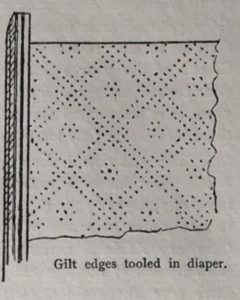
The back is smooth, except the end panels, which are covered thickly with impressions of cords; over the kettle-stitch is a raised band, with slanting lines to imitate cordage.
The decoration in blind block tooling is identical on both sides. The inscription runs: laudate eum in cymbalis bone sonantibus laudate eum in cymbalis jubilationis omnis spiritus laudet dominuin. The angels are playing-shass’m, triangle, bells, mandoline, organ. harp.
The technique of the metal block is so nearly allied to that of the one previously described that it is not unlikely that they are of the same origin, whether used in Paris by Kerver, a German emigrant, or in Utrecht. It is by no means improbable that the volume, which was intended for a better class of readers, may have been issued in this style of binding by the publisher, that is, by the printer himself. The tooled gilt edges are one of the earliest specimens of the kind known, as it is probable that the binding is not much later than 1513. Other copies of the work must still be in existence elsewhere, and an examination of them would no doubt settle the question.
Plate XII.
RICHARD’ SCTI VICTOR’S opera omnia.
Paris 1518 (J. Petit.) Cassel, patr. lat. R. fol. 3.
The watermark on the end-paper is a shield bearing 3 lilies and surmounted by a crown; a small t is appended below. On the cover is a memorandum of price.
Binding: pasteboard, covered with polished brown calf Strings. 330, 240, 45 mm.
Sewing: 4 bands of brown slit leather. Headband a strip of vellum spun over with silk.
The pointed arch frieze, identical on both covers, has been impressed with a tool containing two arches. The leaflets on the points were stamped separately and often crooked. The centre block consists of a continuous framework or border including the beading and an inset with z interlocked pieces of arched frieze A similar arrangement of the stamps occurs elsewhere, for instance, on a volume bound by Ott Heinrich in Cassel, where 2 cartouches appear, the one inside the other, the inner appearing by itself on another binding of Ott Heinrich’s.
As regards the present stamp, an absolute proof the accuracy of my contention is furnished by the volume: Marburg IVb C. 453 (a reprint of jocundus’ edition of Vitruvius s. 1. 1423). therefore add a description of this volume,
Binding, thin millboard covered with brown leather, strings, 1 brown leather bands (torn), kettle-stitch too. 30 mm.
Headband: a twisted strip of vellum spun over with blue and white double thread on an underlay of linen, fastened externally to the kettle-stitch band (the damaged binding allows this to be seen). Back panelled with diaper and little stars. Edges tooled with diaper of double dotted lines with little stars in the spa,(,,,
On this volume the border of our Plate XII is used with a plain centre. The measurements, minutest details and faults are identical. Consequently. either the same tool or a duplicate must have been used.
The Bookbinder for 1888, p. 74, contains some statements about block and roll tooling which must be modified in accordance with what has been proved above. On Cod. III, p, n, 2 and 122. our border is also given from a volume in Worcester cath. libr. Whether these caricatures really represent a tool identical with ours, it is impossible to say. After what was said above, Plate X B, this may very probably be the case. Definite results, the separation of local groups, will only be possible by cautious inferences from peculiarities of the’ actual binding, written entries in the book or in catalogue, watermarks &c.
Plate XIII,A.
ASCONII PAEDIANI expositio in IV. orat.M. T. Ciceronis. Venetiis 1522.Marburg IV b. C. 637-
Binding: thin, white millboard covered with black morocco too, 165, 3o mm. 4 strings, edges uncoloured. 3 double cords and kettle-stitch.
Sewing as usual. Through the kettle-stitch hole of each sheet a second and thinner thread has been passed over the end of the paper, wound several times round the headband and then passed in again through the hole of the next sheet. The pad thus formed has then been neatly spun over with red and green silk. The fly-leaf without watermark has an entry of the end of the 17th century, which, however, is valueless for determining- the provenance.
The decoration is identical on both sides, except the inscription, which runs on the front cover: ASCON. I II PAE I DIANI. Block and inscription are in gold, the border is blind-tooled. The oriental character of the ornaments is unmistakeable I consider the binding to be Venetian of the same date as the book, probably the publisher’s binding. An examination of a number of Aldines in contemporary bindings has led me to the’ conviction that Aldus himself had no share in the artistic development of binding, and particularly not in the rise of the Maioli and Grolier type. As all that he cared for was the legibility of his types, good paper, and handy size, and as the tastelessness of his titles, the absence of initials and even of paragraphs in his books show his lack of artistic feeling (nothing else could indeed be expected from a bookworm), it is inconceivable that the same man should have distinguished himself as a creative artist in his bindings. He may, however, when occasion arose, have employed the services of independent artists, whose names the reknowned and wealthy publisher then suppressed or eclipsed.
Plate XIII,B.
RANGOVZE, Lettres panegyriques aux heros de la France. Paris 1647.
Cassel, philolog. 8°o. 346.
Detached letters without pagination. At the head of this copy is a letter to the Landgraf of Hesse, after which comes the preface “au favorable lecteur”.
Binding: strong pasteboard, morocco, 170, 135, 15 MM, covered with dark red decoration: the shield, of leather mosaic, shows a scarlet fesse with 3 golden stars on a field of dark green’ ovals are also green Each panel of the back contains the saT., monogram as the ovals with laurel twigs. At top and bottom a panel powdered with stars.
The shield is the coat of Cardinal Mazarin (cf. that .givehte‘ be Luthmer [from: les armes du bois, du tissu et du papier] in the Kunstgewerheblatt 1885, p. 84). Fronm what has been said above it would seem that Mazarin had the book bound in his own style and presented it to the Landgraf.
That the book must at one and the same time have stood in some relation to both the position of the letter (in view of the fact that The book belongs to the Hessian library) and of the shield.
Plate XIV.
M. ANTONNI COCCHI SA.BELLICI opera.
Basel (Herwag) 1538. Cassel. hist, uniy. fol. 12 Lit. N. in Fol. Nr.
volumes in uniform binding,
BIndings: Pasteboard (16 ply) covered with polished bright leather. :3v, 37o, 7o nun. Greenstrings. Edges smooth gilt.
Sewing: 6 double cords and kettle-stitch. The headband is fastened into the pasteboards and spun over with a green and gold thread, fastened into and passed under the kettle-stitch at every sixth turn.
DEcoration: The same on both covers, except that the inscription on the reverse cover runs: Ingratis | servire | nephos). On the lower margin of both covers of both volumes is:THO. MAIOLI et AMICORVM. It is unnecessary to waste further words on the value and interest which these on the whole well-preserved volumes possess for the history of art. Ihey belong to the earliest of their kind, but must rank partcularly high for the clearness and beauty of their design. All that is inharmonious, in my opinion, is the border of segments of circles. the bands of the design have been painted with brilliant lacquer. now, unfortunately, partly rubbed off; the outer border is black, white, black; the rectangular interlaced and the inner oval borders are both black. The free scrolls are yellow ochre, the round and crescent-shaped fields in the volutes and knots are carmine red. The flowing leaves which form the terminals of the scrolls in the 4 corners are lavender blue. ThE centre segment border and the bands of the strings are painte white; the whole enclosed by neat gold contour lines.
As the above signature shows, the volumes came to Cassel from Heiderberg. As to how they came to Heidelberg we are quite in the dark. I imagine that the influence of the connection with Paris through Lieselotte (see the Introduction) may be traced here too. It may also be worth investigation whether Maioli’s library may not have been sold by auction after his death and so have been dispersed in all directions.
Plate XV,A.
FRANCISCUS RAFAEL, de exilio Christi et ec-
clesiae sponsae ejus . . “Wittenberg 1563.
Cassel poet. lat. 410 67.
Binding: Millboard covered with rough brown calf, 160, 2 10. Blocked in gold; smooth gilt edges. Sewing as usual.
At the top of the fly-leaf in manuscript: B. W. D. Z.: at the bottom: 15 PC 63 Casimir Pfalezgrafe.
Plate XV,B.
URBANI REGI , deutsche Bucher and Schriften,
Nurnberg 1562.
fiies.sen V. 37, 542.
Binding: Strong (16 ply) pasteboard, covered with dark stained polished calf. 210, 310, 10 mm. (Block 187 long.).
SewIng; 5 double cords and kettle-stitch. Headband: red, blue and white silk worked in double stitch over a string on a broad strip of vellum. a strings of yellow silk. The photograph only shows the central block.
Decoration: a double border of blind-tooled lines, the outer being filled with the shaft of a candelabrum between chains, encloses a large block in gold, leaving two compartments free, the upper containing the inscription: Von Gottes Gnaden | Christoff Herzog zu Wurtenberg etc., and the lower the date 1565 in gold.
The gilt edges are decorated with scraped and punched scrolls of great beauty. In one of the compartments of the top edge is a horse. On the back are chain borders between the bands, in the centre a flower. The watermark of the fly-leaves is a tower with 3 vanes and gargoyles, the wire border is distinguished by groups of thicker lines.
The binding is no doubt of Stuttgart origin, and probably came to Darmstadt as a present.
Plate XVI.
CORPUS DOCTRINAE CHRISTIANAE (des
Herzog Joh. Wilh. v. Sachsen) Jhena 1570.
Cassel, theol. clogm. poi. fol. 31.
Binding: Strong millboard covered with brown calf. 210, 328, 40 mm.
Sewing: 5 double cords. Headband blue-white. Edges gilt, with punched etched and painted scroll-work.
For the decoration three blocks were used. One, a large one, impressed all the bands up to the center, and was duplicated, so that the monogram H. W., which occurs right and left half way up, is once printed reversed. The bands formed by the swelling up of the leather when the contours and hatching were tooled in gold with this stamp have been painted with dull lacquer blue, white and red — and differently on each cover. The empty centre panel was then filled with the portrait of the Herzog Joh. Wilhelm on the front, and the Saxon coat of arms on the reverse cover. The panels of the back were also painted with diagonal bands in three colours.
Plate XVII.
BIBLIORUM pars I. Frankfurt a M. 1575.
Cassel, biblia lat. fol. 14.
Binding: Strong pasteboard covered with brown calf. 24o, 390, 45 mm.
Sewing: 4 double cords and 5 single cords with kettle-stitch : the single bands have also been used. Headband blue and red over rolls of paper on a strip of vellum. Edges gilt with punched scrolls, the leaves of which have been etched.
Decoration identical on both sides. Several series of skilfully interlaced scrollwork, bordered with gold, form a network over the whole cover: the scroll enclosing the 4 larger white compartments is pale blue, that round the angular red compartments is silvered. The compartments have been inlaid with thinly pared white leather, that in the angular ones was painted carmine red. The little circles in the knots of the scrolls have been painted vermilion direct on the leather. The ground is sprinkled red, bluish green, yellow and white; the interspaces powdered with gold dots. Delicate scrolls, terminating in gold powdered with gold dots. Delicate scrolls, terminating in gold leaves azure, run over the ground and pass through the borders Into the compartments, thus toning down the effect of the loud colours. The outer gold-bordered band is painted green. The bands on the back have diagonal stripes of gold (rope pattern!); the double bands have a centre line. The panels of the back are bordered with red and blue alternately, and bear 2 gold flowers. The edges of the boards have alternate long and diagonal gold lines, corresponding to the divisions of the bands.
The shield and the monogram, F(ridericus) P(alatinus) C(omes) show that the binding is the work of the Heidelberg court bindery, and was incorporated as a present in the collection of bibles formed at Cassel by Wilhelm IV.
Plate XVIII.
CONCORDIA, christliche wiederholte einmatige
Bekenntntis nachbenannter . . . Tiibingen 1580.
Cassel, hist. eccles. ref. fol. 4.
Binding: Strong pasteboard covered with calf. 210, 325, 6o mm. 6 double cords, kettle-stitch and headband worked in red and white on a strip of vellum. Strings. Edges gilt, punched and etched.
Decoration identical on both sides. The bands caused by the impression of the large block are painted with red, white and green lacquer. A small block has been clumsily impressed in the centre field. The reverse cover has another border roll, having a small shield with appended monogram HP between scrolls. The monogram appears alone on the front edge. The reverse cover was too much damaged to be photographed. The cartouches of this volume are often met with in identical or almost identical form; a fact which is easily intelligible on theory, Plate Xb, of cast duplicates and retouching by means , of the graver. I may adduce: 1, a beautiful white blind tooling V.Giessen X. 7171. Here the portrait of Herzog Christoph
Wartemberg is in the oval. The difference of the smooth oval border may be due to the engraving of the leaves on the latter, and the former may be the original. To the latter class belong: 2, Cassel, philos. gener. f. 41 2 ; 3, Marburg XIV c 532b; 4, Giessen S. 39, 883. No. 3 contains the entry : emptus Tubingae ao :605, which agrees with my theory that the tool was manufactured in Stuttgart.
Plate XIX.
A. Cassel B. Marburg C. Marburg D. Giessen
bibl. lat. 4t. 13. Yalb B 26k6. Dr. E Justi. V. 16,o6o.
E. Marburg, Staats-Archiv.
I have here grouped 5 copies of one book together. 3 are photographed here, the one marked D is of such defective execution and so ruined that a photograph would scarcely be recognisable. It was only by a ‘very skilful arrangement of light and at a considerable cost of time that it was possible to decipher the inscription from which we learn the name of the author of this interesting group of bindings: at last, however, it was done with certainty.
Davidis rcgii prophetae Psalterium I vario genere I carminis latine redditum ab illustrissimo princi I pe ac Domino
Mauritio HaFsiae Landgravio etc. Excussum Schmalkaldiae. In copies C and D the last leaf has the Hessian shield and under it: Schmalkaldiae Michael Schmuck imprimebat 1593.
Of the above-mentioned copies the following have autograph dedications of the Landgraf’s:
A. Joachimo Abbati Hersfeldensis Ecclesiae amico suo donat . . . 13 Julii 1595.
B. Academicae Bibliothecae Marburgensi dicatum donatum. 6 Januarii eod.
C. Illustrissimo principi L. Georgio patruo carissimo donat . . . 10 Maij eod.
D. without any autograph dedication was in the library of the treasurer, “Conrad Bachmannus Milsungensis”, who was a friend of the Landgraf’s.
The 2 copies in the Court Library at Darmstadt have unfortunately no binding which belongs to this group; one of them was formerly in the library of the Landgraf Philipp in Butzbach, and has the Hessian lion in gold on brown leather with border lines.
Binding: alike on all ; thin pasteboard, 185, 150, 25 mm. In the case of A B C the board has been covered with polished pig vellum, which has been perforated in the manner shown so that a coloured underlay is revealed. The underlay of B is of green satin with a loose network of gold thread; A has red, C. green satin without the gold; D is covered with calf, E with red paper. The further decoration consists of gold-tooling as shown on the photographs of the 3 ; the decoration of E is a plain roll border with a centre ornament in gold. That of D is remarkable.
As in the case of B and C, a roll forms the border. The centres are occupied by 2 different rectangular blocks , while the corners with figures of angels in triangular cartouches touch the centre piece. The remaining compartments are painted blue with black diagonal stripes on the front, and marbled white on the end cover. The corners and blocks are entirely gilt, pressed in relief and then lavishly painted with a variety of glazed colours in a very unskilful manner. The front block has the Hessian shield in an oval frame with inscription, in the corners are poor cartouches with the heads of angels; beneath is a tablet with an inscription. The inscription round the shield runs:
VON . GOTTES . GNADEN . LANDGRAFF . MORITZ . SIMBOLVM . CONSILIO . ET . VIRTVTE . BEDECHTIG . VND . KIEN (kuhn).
The tablet :
HANS . BAPEST . VON . ERFFVRDT j BVCHBINDER . IN . SCHMALKALDEN.
The block of the reverse cover has a broad border of a scroll with large flowers, enclosing a lozenge-shaped field with a bouquet of flowers in a vase. The block was also impressed in gold on the volumes A and C; perforations were then made to take the place of the flowers, so that the scroll winds in between the vase of flowers also determined the character of of perforations and is still recognisable. The perforations were made by the aid of hollow chisels and a toothing iron, such as saddlers use. The back of B is also perforated and underlaid. The, centre of this volume’ is differently decorated here, as may be seen the photograph.
Plate XX.
DRELINCOURT, les consolations de lame fickle conte la mort.
Charenton 1651. Cassel, theol. moral. 4th 3.
The work is dedicated to the Landgrafin of Hesse: la douairière princesse de l’impire, that is, to the Landgrafin Amalie Elisabeth.
Binding: millboard covered with dark scarlet red morocco. 240, 190, 30 mm.
Sewing: 5 bands and kettle-stitch. Headband worked with silk. Plain gilt edges.
Decoration: in the style of le Gascon-Badier, covered with very delicate filigree ornament, composed entirely of small tools and surrounded by a roll border. The panels of the back are decorated with corners and a centre flower of filigree ; in the second panel from the top is the title: Consolations I contre la mort.
Plate XXI.
DRELINCOURT, les consolations . . nouvelle edition.
Charenton 1669.
Cassel, theol. moral. 410 2.
With the same dedication as the preceding volume, although Amalie Elisabeth had died in 1651. The dedication is also continued in the succeeding editions.
Binding: Millboard covered with dark scarlet morocco. 260, 200, 30 mm.
Sewing: 5 double cords &c., as above, gilt edges smooth. Panel. of the back similar to those of the preceding, even to the title.
The character of the ornamentation is essentially different to that of the foregoing volume, but both may again be distinguished from all succeeding Heidelberg bindings by the absence of a definite outline, which, in the latter cases, is always furnished by wavy bands or by line borders.
The first volume (Plate XX) may be the work of Le Gascon himself, but can never have been produced in Cassel or Heidelberg. If it is one of the copies mentioned in those catalogues, the Pfalzgrafin must have received it shortly after the death of her mother — consolations contre la mort — as there is no doubt that a bound dedicatory copy reached her hands. Further research would perhaps give a still more definite conclusion. It is not beyond belief that the first copy, on its arrival at Heidelberg, gave the impulse to the adoption of this beautiful style and to the purchase of the requisite tools.
Plate XXII.
BIBLIA, d. i. die ganze heilige Schrift etc. Frankfurt aM. 1668.
Mit churpfalzischem als d. h. Reichs Vicarii . . . Privilegio.
Cassel, Biblia germ. fol. 3 (H: geistliche Biicher fol. 23).
Binding: Strong millboard covered with red morocco, 465, 290, 120. 6 double cords, kettle-stitch, headband worked with coloured silk over a pad on a strip of vellum. Plain gilt edges.
Decoration : The panels of the back are enclosed by double lines, and have triangular corner and lozenge-shaped ornaments composed of the small tools used for the front side as well as some which occur on plate XXIV.A. A. roll of ovals anti, diamonds runs along the bands, Both covers have been treated in pure filigree style, so that it is very possible that the border too may have been produced by actual wire filigree. The rayed rosettes so characteristic of the German filigree style (they have also been compared with fans) have here been worked with a semicircular tool.
Plate XXIII.
DIEDERICH VON DEM WERDER (Oberster),
Gottfried oder erlosetes Jerusalem.
A metrical translation of the well known original.
Frankfurt a,M. 1651.
Cassel, poet. ital. 4t. 5. (H: Aa in Quarto I 7).
Binding: Millboard covered with red morocco. 24o, 190, 40 mm. 5 double cords, smooth gilt edges.
Decoration: as shown, the apparently darker colour of the bands is due to rubbing. In each panel of the back is an oval line surrounded by delicate pearls, the centre occupied by a filigree rosette surrounded by numerous gold dots. The design is perfectly clear, effective and carefully executed. The engraving of the tools is excellent.
Plate XXIV A.
VON DER LINDEN, Hyppocratis opera. Lugduni
Batavorum 1665.
Cassel, med. oper. 8v0 4. (H: Aa in Quarto 68 & 69).
In manuscript on the fly-leaf: Serenissimo principi Carob
Comiti Palatino hunc . . . ejus Bibliothecae dedicat et offert .. .
Andreas Steigerus med. Dr.
Binding: Millboard covered with bright red morocco. 205, 118, 44 mm.
Decoration: The panels of the back have exactly the same rosettes as No. 23, except that the inner gold dots are exchanged for rings.
The arrangement of the covers is also similar, only the bands are stained dark, enclosed with double contour lines and the rings and loops of the filigree lozenges have been filled up with silver dots. As has already been remarked by Adam : der Bucheinband p. 248, the silver has been mixed with white, in order, I take it, to prevent tarnishing and to diminish the glitter
which might impair the effect of the gold. The half rosettes have here been worked with one stamp. To conceal any inaccuracy of joining, the ends of the contour lines were very effectively covered with gold dots.
Plate XXIV B.
THOMAS WILLIS, de anima brutorum .
Oxonii 1672.Cassel, log. metaph. 4t0 24. (H; lit. 0 in Quarto 5).
Binding: Millboard covered with calf. 23o, 170, 37 mm. Edges uncoloured, sprinkled red and black.
Decoration : Each panel of the back is enclosed by lines of gold
and rows of dots running beside the bands; the second panel from the top bears the title: WILLIS . DE. I . ANIMA . BRVTOR. I The other panels have a centre rose of rings filled with silver, and on each side a large tulip in gold.
The covers have a broad, dark stained border (the surface has peeled off considerably). The bands are painted or stained black. The centre of the whole and the pointed leaves and larger rings are filled with silver.
Apart from the gilding, which has been spoilt by the bad leather, the effect of the cover is good. Only 12 tools, including the lines and dots, were used.
Plate XXV. PHILOTHEI, Symbola christiana. Frankf. alM. 1677.
Cassel, Emblemata fol. 9. (H: lit. N. fol. 36, besides this 2 bound
and 6 unbound copies, none of which are any longer in Cassel).
Dedicated to Professor P. Hachenberg of Heidelberg.
Contains a number of quite dreadful emblems engraved in
copper, with Latin verses appended. The pseudonym stands for the Pfalzgraf Carl, the founder of the new Court Library. This also accounts for the number of copies.
Plate XXV.
PHILOTHEI, Symbola christiana. Frankf. alM. 1677.
Cassel, Emblemata fol. 9. (H: lit. N. fol. 36, besides this 2 bound
and 6 unbound copies, none of which are any longer in Cassel).
Dedicated to Professor P. Hachenberg of Heidelberg.
Contains a number of quite dreadful emblems engraved in copper, with Latin verses appended. The pseudonym stands for the Pfalzgraf Carl, the founder of the new Court Library. This also accounts for the number of copies.
Binding: Millboard covered with bright leather. 360, 230, 20 mm.
Decoration : Gold-tooling: the detached ornaments in the interstices of the bands, the pointed leaves and the 6 semicircles on the inner side of the centre border are painted silver. The filigree rosettes have here been produced with a tool holding only a sector, with which, of course, strictly speaking, only one rosette (or a half or quarter) of definite diameter could be produced. Whole sets of them, probably of various patterns, must have been on hand in every well-equipped bindery. How they contrived, in purely mechanical manner, to turn out by hook or by crook rosettes of larger sizes, will be seen in a number of the following bindings. We should scarcely approve of such dodges now-a-days.
Plate XXVI.
L. BEGER thesaurus ex thesauro Palatino selectus
seu gemmarum ex numismatum Heidelberg 1685.
Cassel, Numismat. fol. 13.
The vignettes consist of beautiful views of the castle of Heidelberg. On the fly-leaf the autograph dedication: Serenissimo et potentissimo Principi ac Domino I Dn. Carob I Landgravio Bassiae I etc . . . . Augusto Eruditae Antiquitatis Aestimatori. ( Banc I Devotae Venerationis Suae Tesseram I qua Submission Fas est I offert Author.
Binding: Pasteboard covered with bright, smooth leather. 400, 25o, 5o mm.
The arrangement of the decoration is meagre and unpleasing, and the effect by no means corresponds to the labor expended on the gilding.
Plate XXVII.
L. BEGER, thesaurus Brandenburgicus .. gemmarum
et numismatum . . . . Coloniae Marchicae 1696.
Cassel, Numismat. fol.
Contains among other things some fine copper-plates with a bird’s eye view of Berlin, the Schloss and Cathedral, a view of the interior of the hall of gems &c.
On the fly-leaf a similar dedication to that of Plate XXVI:
Serenissimo … celsissimo Scientiarium Asylo I . . . pro Regio ante
Decennium Dono* … Tessarum offert Author.
Binding: Millboard covered with bright leather, 400, 255 5o mm. Smooth gilt edges.
Decoration: Roll border in filigree style; interlaced bands painted black, the panels filled alternately with filigree ornaments and natural flowers in vases. The ground powdered with gold rosettes. The finials of the filigree scrolls are tipped with con-ventional flowers, such as are also found on older and richer
examples of metal filigree work.
Plate XXVIII.
L. BEGER, L. Annaei Flori rer. rom. lib. II.
Coloniae Marchicae 1704.
Cassel, hist. Graec. et Rom. Fol. 26.
Manuscript decoration : Serenissimo .. principi . . . Carob
Hassiae L. . . . offert author. Friedericoburyi Marchicae 12. Aug. 1704.
End-papers and lining a blue-gold fancy paper of pretty pattern.
Binding: millboard covered with brown calf, 400, 250, 45 mm. Smooth gilt edges.
Decoration: as shown; the black bands forming elongated quatrefoils. The sprays of flowers are composed of detached curves and leaves. The quatrefoils are filled with a similar filigree work to the preceding volume. The general arrangement as an undeniable likeness to the gilt leather tapestries which were so popular just at that period, especially in Low German
districts. The phenomenon is not singular. The stimulus caused by the transfer of designs from one branch of industrial art to soother has generally been beneficial; in times of decay, indeed, detrimental. Without claiming to be exhaustive, the following are some of the parallels we have observed: models for the ornamentation of books were, in the 15th century, the metallic style with engraved and chased plates (blind tooling and scored
work); in the loth, the intarsia (Maiolii Grolier); in the 17th, the filigree (le Gascon-Heidelberg style); at the end of the 17th and beginning of the 18th, the tapestry style, in the 18th, the lace style.
*) He received this royal present for his exertions in connection with the
ieidelberg Library.
Plate XXIX.
JOH. BERGII, 39 Predigten. Frankfurt a 0. 1664.
Cassel, theol. past. horn. 4t0 36. (H: lit. T in Quarto 32.)
The work is dedicated to the Markgrafin Louise of Brandenburg.
Binding: Millboard with bright red morocco, 205, 150, 75 mm.
Edges gilt with scraped lozenges and punched contours, on each side a compartment with a fan rosette with chain pattern border.
The decoration of the cover differs, both in the general arrangement and in the character of the tools used, from any given in this volume or that I have seen elsewhere. Its metallic character is conspicuous in the fuller and more uniform covering of the ground. With a few modifications the design might be used as a pattern for metal-work. It is remarkable how few tools have been used. A / and a shaped > filigree tool, the sector for the rosettes with the points and dots, a number of tiny dots, flowerets, one round tool, and 4 rolls, only 15 pieces, including the lines.
Plate XXX,A.
BROWERUS, Fuldensium Antiquitatum lib. V.
Antwerpiae 1612 (ex off. Plantiniana.)
Manuscript entry on the title-page, partly cut away when rebinding: at top: Sum ex libris. .lat bottom: Ego Wolfgdono accep Prof. Ord. Herbip. dono Kolbio Can . admodum dO Duo Annico Novi bros. Monasterij Kolb N Monasterii Canonico 5 Junii 1645.
Before the present binding was put on , therefore, the book must have been in the hands of two owners and, in fact, in Wiirzburg where it was probably rebound. The watermark of the end-paper is STWM in a border.
Binding: Millboard covered with common tanned leather, 170, 24o, 27 mm. 5 cords and kettle-stitch; the headband sewed in long stitches with white and blue thread on to a strip of linen pasted to the covers. The volume is very firm, but opens well. Edges gilt. 2 strings.
Decoration: Gold tooling with rolls. The outer is a modification of the old Gothic floriated border; the centre piece, like the corners, is combined from a number of tools and has in its centre a gem in imitation. The tool with the crown reminds one of the Cassel volume XXXIX. The disappearance of the gold is probably due to the oil in the leather.
Plate XXX,B.
H. DE CHERBURY, de veritate . . . . 2nd edition,London 1633.
Cassel, log. met. 4t0 22.
End-papers and book have similar watermarks.
Binding: Millboard covered with chestnut morocco, 235, 180, 2 mm. Sewed on 4 flat, non-projecting bands and 3 broad, glued-on vellum strips, headband worked with green silk on a strip of vellum (?), narrow green strings, smooth gilt edges.
The decoration as shown on the Plate is combined from small tools and the gilding is excellent. The back is covered with a series of scrolls in which and in the semicircles thus formed there are little flowers. In spite of the inaccurate execution, the use of the tools cut from a French pattern (Eve) is interesting, as the binding is probably an English one. The use of the “fanfares” in this way has not, I think, been published previously.
Plate XXXI.
A FOREST OF VARIETIES (anonym.). Lond. 1645.
Cassel, poet. angl. fol. s.
Binding: Millboard covered with dark green morocco, 280 185, 30 mm. red strings now torn off, smooth gilt edges.
Sewing as in Plate XXX.
Decoration: good gold-tooling, with roll borders and a number of detached small tools combined in an original but unpleasing manner. The straight portions of the symmetrical centre piece have been produced with a tool intended for fan rosettes (cf. Plate XXV). This binding also seems to be of English origin.
Plate XXXII,A.
R. HOOKER, of the Laws of ecclesiastical politic.
London 1636.
Cassel, hist. eccles. region. fol. 14.
(H: in dem Schrank bey lit. G 2, in Goldt and seiten gestickte
Decke gebunden.)
Bound along with other works of the same author in a volume with continuous pagination. The single titles with a very rich, remarkable cartouche.
Binding: Stout millboard, 290, 190, 60 mm. Covered with white satin, on which a baroque border is embroidered in relief with gold thread. Within the border is a figure embroidered in flat in various colored silk: the colors of the robes being surrounded, as in glass-painting, with firm outlines of corded gold thread. The outer ground is sewed over with silver spangles, the inner with fine little rolls of wire. In a capsule covered with colored. paper. The occasion of this sumptuous but very unsuitable binding cannot now be discovered. It was probably a court present, and, judging from its style, was no doubt produced in England.
Plate XXXII,B.
DES HEILIGEN ROMISCHEN REICHS .. .
genealogischer Kalender fur 1765. Frankfurt a M. 1765.
Giessen, G. 10, 73o (formerly: “bibl. aulica Darmst.”).
Binding: Thin millboard covered with pink satin. Small 8vo. End-linings of green satin, smooth gilt edges.
Embroidery in gold and silver, with the monogram of the Landgraf and the Hessian lion.
Plate XXXIII.
THE HOLY BIBLE. Oxford 1680.
Cassel, Bibl. angl. fol. 1.
Stout pasteboard covered with black morocco. 7 double cords, smooth gilt edges, 510, 315, 45 mm.
Decoration: the corners and the two narrow inner borders are of onlaid or inlaid isabelle colored leather, the centre piece and the corners added to the round border are of red leather, covered with the most delicate and profuse leaf and flower filigree
work. The whole is surrounded by a border of the same scroll work. The design, which appears very complicated, has been
executed with very few small and tiny tools and carried out very neatly and accurately. The broad back is also decorated with two patterns in which stalks occur from another set of filigree tools with beaded scrolls and long leaf stalks combined from single pieces. The striving for finish which is so early noticeable in English art work is unmistakable in these sharply and accurately cut tools and their application. The volume is unfortunately much rubbed and bruised.
Plate XXXIV,A.
JUGULUM CAUSAE seu … ratioper quam
doctrinae Romanensium complexus . . et unt
Papa . . evertuntur.
Juxta exemplar Londinense 1671.
Cassel, theol. dogm. pol. 8vo 406.
Also contains a letter addressed to the Pfalzgraf. The book was formerly in Heidelberg under the shelf-mark Lit. E 8,0 31 & 14, so that it must have come there a, a present from the unknown author.
Binding: Pasteboard covered with scarlet red morocco, 166, 106 , 30 mm , smooth gilt edges, red silk strings. headband worked in blue and red.
Decoration: Gold tooling with very fine tools showing a great similarity with those of the Bible already described, and probably from the same bindery. From the same workshop proceeded the volume: Cassel, hist. eccles. papal. fol. 6 (History of the Cardinals by G. H. London 1670), the design of which is particularly beautiful but unfortunately could not be photographed
because the cover, of white polished pig vellum, has been marbled in a really awful manner with large, glaring green , pink, carmine, yellow, violet and brown blots. Several identical stamps, including some of identical design and different size, occur. The end-paper of both has the same watermark, and the variegated volume is shown to be a presentation copy by the manuscript entry: “A Johanne Thorowgood milite de I Kensington juxta Londinum nos I sumus humillime oblati”; which is a proof that the three volumes here described are of English origin.
Plate XXXIV b.
SPANHEIM, discours sur la croix de notre seigneur.
a Geneve 1655.
Cassel, theol. past. hom. 8,0 18. (1-1: Lit. Q 8″ 6.)
The work is dedicated to the Pfalzgraf, and the entry “pour son altesse Madame la princesse Elisabeth” permits us to guess that this copy is a presentation one from the author.
Binding: Millboard covered with dark scarlet red morocco, 195, 120, 20 mm. Smooth gilt edges.
Decoration: Very original, differing from all those previously described, although there is a certain similarity in the tools employed. The small heraldic lilies, too, are probably not often met with elsewhere. The binding is of Genevese origin, the manifold fly-leaves having the same watermark as the work itself. But only one half of the watermark is found on each of the 6 fly-leaves which the volume now possesses.
Plate XXXIV,c.
COMENII, Janua linguarurn et rerum.
Schaffhausen 1656.
Cassel, philolog. 190 (H: lit. o in octavo 22).
Binding : Millboard covered with bright red morocco, 165, 100, 20 mm.
Decoration: Filigree ornament of a quite different character from those shown above to be of Heidelberg origin.
Plate XXXIV,D.
J. BOSSEE, Nieuwe reductie der Gelden . vor
alle militaire officieren. ‘s Gravenhag 1746.
Cassel, are militaris 8v. I.
Binding: Millboard covered with scarlet red morocco, 200, 125, 20 mm. Linings of colored and gilt paper; smooth gilt edges.
Wild filigree work of defective execution on too thick and soft leather. The binding must have been produced in numbers on the spot, as at the end of the index in every copy the author has placed his autograph, “om alle abu)sen en het copieren van dit Boek voor to komen’. (the defective workmanship and the circumstance that the ink has not set off or blurred during the process of binding, to which beating then belonged, speak in favor of a Dutch publisher’s binding.
Plate XXXV.
PAGENSTECHER, Jrnerius injuria vapulans.
Groningen 17.31.
Dedicated to the Landgraf Carl.
Cassel, jus. civ. comm. 4to 4i.
Binding: Millboard covered with red morocco. 205, 17o,3o mm.
Decoration: Still in filigree style, in which, however, there is already a strong admixture of naturalistic elements. The rich composition is of interest, as there is little doubt of its Netherlandish origin.
Plate XXXVI.
J. MASEN1US (S. J.), Anima historiarum . . . hujus
temporis . . . Caroli V et Ferdinandi I imperio
expressa. Coloniae Agrippinae 1672.
Fulda III f. B 23.
On the fly-leaf: .ad Bibl. celnii, Principis Fuldensis.
Binding: Millboard covered with bright red, rough leather. 155, 215. 25 mm. Sewed with bands imbedded in the back.
Decoration : A variety of rolls form a double border, with-in which lies a leaf work of ferns. The centre piece is powdered with stars and contains a lozenge of filigree scrolls.
Plate XXXVII.
CO1VITE DE PAGAN, les fortifications du .
Paris 1645.
Cassel, arch. milit. fol. 16.
Binding: Millboard covered with bright calf. 240, 340, 3o mm. 6 double cords. Edges gilt.
Decoration of thick filigree scroll work, surrounded by a roll border, and principally composed of a pair of right and left tools,
centre and corner pieces.
The composition is so exact that it required careful examination with the compasses to ascertain that the corner pieces &c. had not been done with large blocks. One remarkable feature, for example, is the isolated circle of dots in the lower left quarter of the centre, which is not repeated in the others.
The binding is probably of French origin.
Plate XXXVIII.
J. SOLDAN, Bericht von der Kirchen Gottes,
Cassel 1653.
Cassel, theol. dogm. pol. 410 167.
The work is dedicated to the Pfalzgraf Carl Ludwig and the Landgrafin Hedwig Sophie….,•••• •
Binding: Millboard coverea WIL11 WiTK green morocco, 190, 160, 30 mm.
Decoration identical on both sides, the bands imbedded in the back, one panel of which is bordered with the running border of the front side surrounding two oblong ornaments. Smooth gilt edges.
Plate XXXIX.
KLAUTE, sacri romani Imperil leges fundamen-
tales. Cassel rjoI.
Cassel, jus. publ. 4to 113.
Binding: Millboard covered with red morocco, 235, 190, 30 mm.
Decoration: Dotted filigree work with finials of close spiral volutes mixed with broad crescents of smooth lines terminating in volutes. Surrounded with a border of 3 rolls. On the whole 10 tools and 2 rolls have been employed, the former being of
excellent engraving and, for their period, of astonishing delicacy of form. The workmanship is perfect and the design skilful.
Plate XL.
BIBLIA, d. i. die gantze gottliche H. Schrift.
Minden 1707.
Cassel, bibl. germ. fol. 17.
Binding: Stout pasteboard covered with smooth white pig vellum, 240, 360, 80. Cast metal gilt clasps. Sewed with 6 double cords and kettle stitch. Headband worked with red-white thread on a strip of parchment. Edges deep blue, with impressed scrolls in which are golden stars. Golden zones at both ends with punched lines and foliage.
Decoration: The compartments are divided by broad bands as in Plate XXVII. The ground color of the vellum is only
retained in the four angular compartments, the remainder, with the exception of the four green corner panels, is glazed a transparent carmine red. Of the gold tooled ornaments again, those of the white compartments are painted green and red and yellow.
The centre panel of the front side bears the inscription:
HIS CAROLINIS I NVNDINIS PRIMIS VNVS PRAESIT I ATQVE TRINVS
ABSENTIA VOVET 1 TOTAQVE I PRAESENTIA 1 OVET.
on the reverse cover, which is here photographed:
SVB PRINCIPE I CAROLO I AVTORE SVO I VT SIBI FLOREAT 1
SIB VRGVM J VRBS CAROLINA I AGGRATVLA I TVR I PLEBS VI I CINA
engraved with small gold and large white letters. The chronogram gives the year 1708, in which year the right of holding fairs was granted to the town of Siburg or Carlshafen on the Weser by its founder Carl ; in recognition of which the inhabitants of the town and neighborhood presented this new edition to the prince’s collection of Bibles.
Plate XLI.
KOPP, Ausftihrung des Hauses Hessen-Cassel Erb-
rechtes auf Brabant. Marburg 1727.
Marburg, Staatsarchiv, X. A. 495.
Binding: Millboard covered with bright red, coarse-grained morocc,. 325, 210, 10.
Plate XLII.
PIRANESI, raccolta di disegni d’il . . detto
Guercino Roma 176 4.
Copper-plate engravings from pictures &c.
Cassel, Ser. artes. fol. 22.
Binding: Millboard covered with brown calf, lightly marbled in dark. 570, 415, 25 mm.
Decoration: A border of handsome gold tooling with well cut tools in chaste 18th century style, such as is not very frequently
found on bindings.
The volume was brought back along with other books of engravings and works of art by the Landgraf Friedrich on his return from Rome in 1777 ; the binding is, therefore, no doubt of Italian origin.
John Fenton.


